19 September 2024
By Maynard Paton
FY 2024 results summary for S & U (SUS):
- A very disappointing FY, with H2 profit slumping 41% and the final dividend cut by 17% as enhanced FCA “forbearance” regulations prompted the “temporary” modification of motor-finance collections and led to impairments surging 74%.
- Various motor-finance ratios unsurprisingly deteriorated, including the first-payment proportion plunging to an alarming 94%, collections of due falling to a below-budget 90%, anticipated repayments hitting a fresh 127% low and up-to-date accounts sliding to 74%.
- At least the property-loan subsidiary continues to perform well, as minimal bad loans led to a new £5m profit high, an impressive 58% divisional return on equity and a company-blog ambition to double cumulative lending to £1 billion “in the next couple of years“.
- Debt advancing to £224m and borrowing rates climbing to 8% caused net finance costs to absorb a significant 13% of revenue; extra post-FY debt could meanwhile take net finance costs from £15m to £19m and exacerbate the profit “headwinds“.
- Post-FY references to “vigorous” FCA discussions, political intervention and up-to-date accounts running at a pandemic-like 69% now leave the £18 shares firmly below NAV, a valuation witnessed only very occasionally during the last 30 years. I continue to hold.
Contents
- News links, share data and disclosure
- Why I own SUS
- Results summary
- Revenue, profit, net asset value and dividend
- Advantage Finance: loan sizes and rates
- Advantage Finance: loan volumes and first payments
- Advantage Finance: collections and estimated repayments
- Advantage Finance: up-to-date and overdue accounts
- Advantage Finance: impairments
- Aspen Bridging
- Boardroom
- Financials: cash flow and debt
- Financials: returns on assets and equity
- Financials: employees
- Regulation: Borrowers in Financial Difficulty
- Regulation: Consumer Duty
- Regulation: SUS response
- June and August trading updates
- Valuation
News links, share data and disclosure
- Annual results, presentation and webinar for the twelve months to 31 January 2024 published/hosted 09 April 2024;
- Trading update published 06 June 2024, and;
- Trading update published 12 August 2024.
- Share price: 1,800p
- Share count: 12,150,760
- Market capitalisation: £219m
- Disclosure: Maynard owns shares in S & U. This blog post contains SharePad affiliate links.
Why I own SUS

- Provides ‘non-prime’ credit to used-car buyers and property developers, where disciplined lending, conservative financing and reliable service have supported an illustrious NAV and dividend record.
- Boasts veteran family management with a 40-year-plus tenure, 44%-plus/£97m-plus shareholding and a “steady, sustainable” and organic approach to long-term expansion.
- Enhanced regulation, economic “headwinds“ plus higher debt costs have left the shares trading below NAV, which history suggests can be an attractive buying opportunity.
Further reading: My SUS Buy report | All my SUS posts | SUS website
Results summary
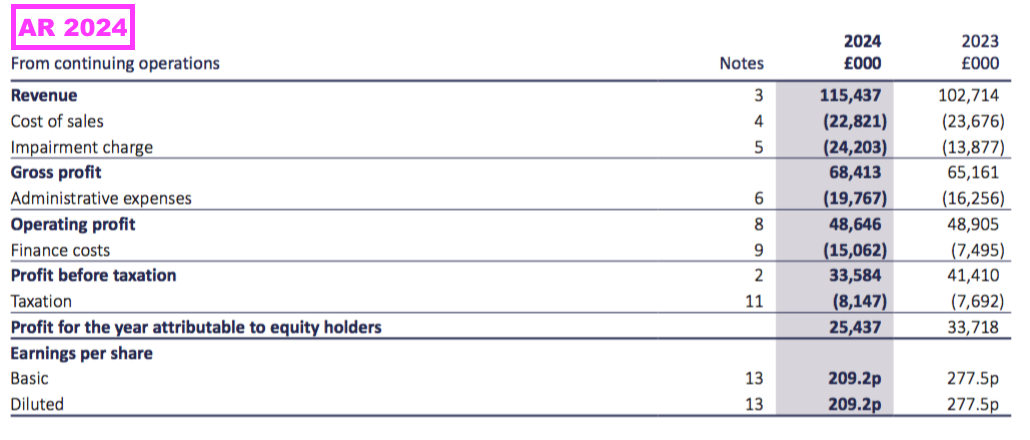
Revenue, profit, net asset value and dividend
- An adverse statement during February that confessed to various “headwinds“…
[RNS 2024] “Since S&U’s last trading statement two months ago, the headwinds I reported then of poor consumer confidence, continuing high interest rates, cost of living pressures and regulation have, unsurprisingly, impacted the Group’s progress and profitability.”
- …and warned pre-tax profit would be 10-15% below the then-£38m consensus expectation…
[RNS 2024] “In particular, the reduction in the rate of collections has necessitated increased provisioning under the IFRS9 accounting standard. Thus, our group profit before tax for the year ended 31 January 2024 is likely to finish between 10% and 15% below consensus expectations of c£38m. Nonetheless, we expect a solid rebound; hence our continued funding investment in both businesses of £15m during the period.”
- ...and announced the second interim dividend would be cut by 8%…
[RNS 2024] “It is therefore right that at a time when the cost of living, funding and regulatory challenges have had an impact on profits, we partially protect returns to shareholders as we also did during the pandemic. Hence this year we propose that S&U’s second interim dividend should be 35p (2023: 38p), payable on 8th March to shareholders on the register on 16th February.“
- …had already heralded this very disappointing FY 2024.
- The lower profit and dividend were declared despite revenue gaining 12% to £115m, which in fact set a new annual peak:
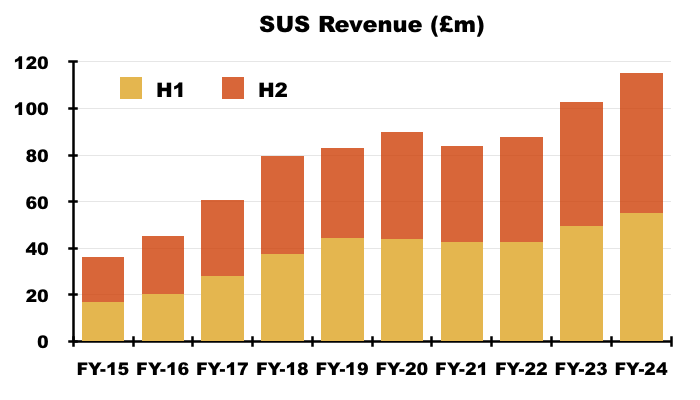
- H2 revenue in fact gained 13% to £60m to set a new record for any H1 or H2.
- Pre-tax profit did indeed reduce by 10-15% below the then-£38m consensus, falling 19% to £34m:
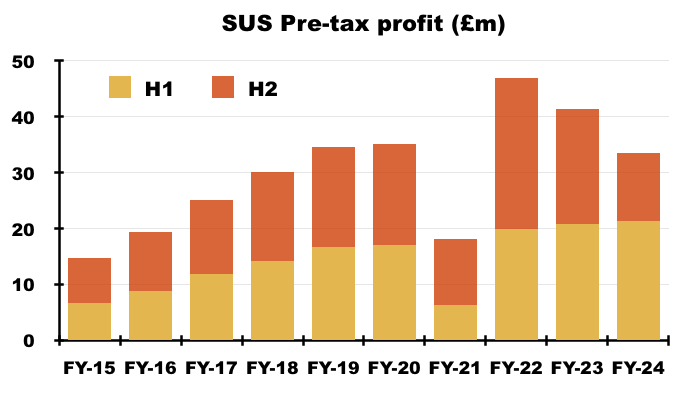
- H2 pre-tax profit slumped 41% to £12m after February’s statement claimed the “headwinds” had been “largely confined” to Q4.
- The FY profit reduction followed loan impairments surging 74% to absorb 21% of FY revenue (see Advantage Finance: impairments)…
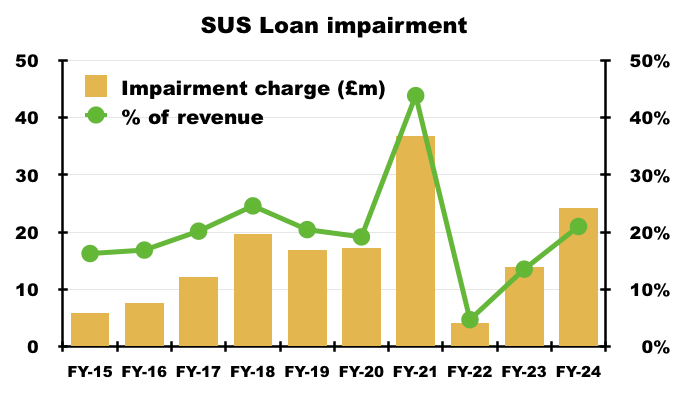
- …and FY net finance costs more than doubling to £15m to absorb 13% of FY revenue (see Financials: cash flow and debt):
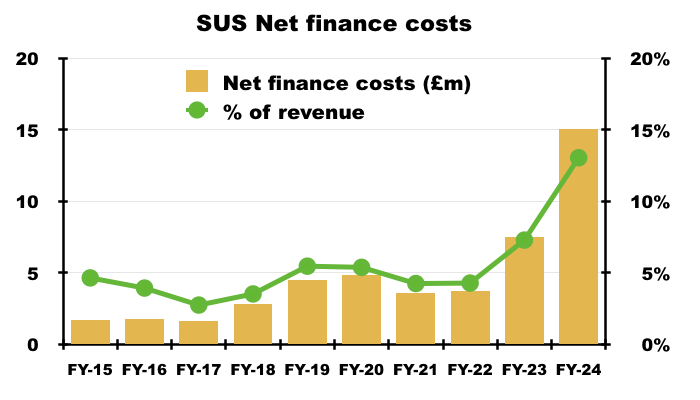
- Greater impairments and finance costs were experienced during H2 versus H1.
- H2 impairments absorbed 28% of H2 revenue (versus 13% during H1)…
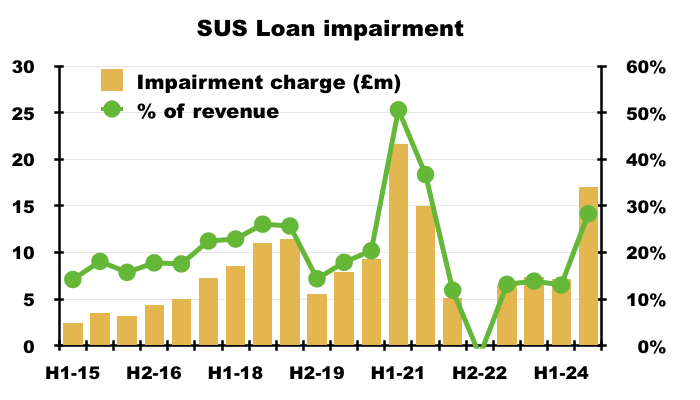
- …while H2 net finance costs absorbed 14% of H2 revenue (versus 12% during H1):
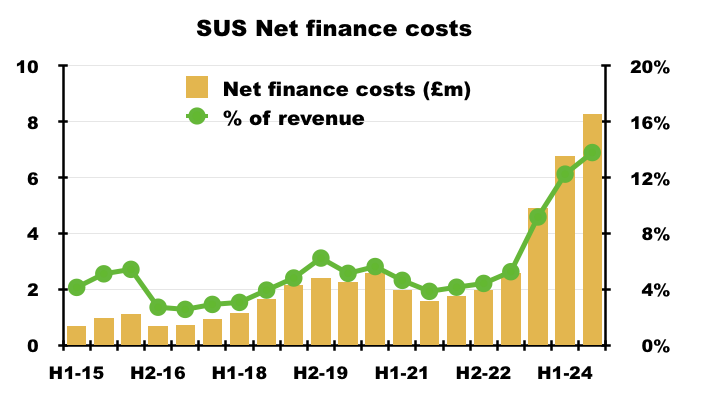
- The pre-tax profit reduction was in part amplified by the comparable FY enjoying “lower than normal” loan impairments:
[FY 2023] “Impairment charge of £12.9m (2022: £3.8m; 2021: £36.0m) still lower than normal as increase in stage 1 and macroeconomic overlays for forecast future inflation and car prices, more than offset by excellent collections and lower than anticipated realised bad debts“
- The accounts continue to be dominated by SUS’s motor-finance division, Advantage Finance, although SUS’s property-loan division, Aspen Bridging, is becoming a greater part of the group:
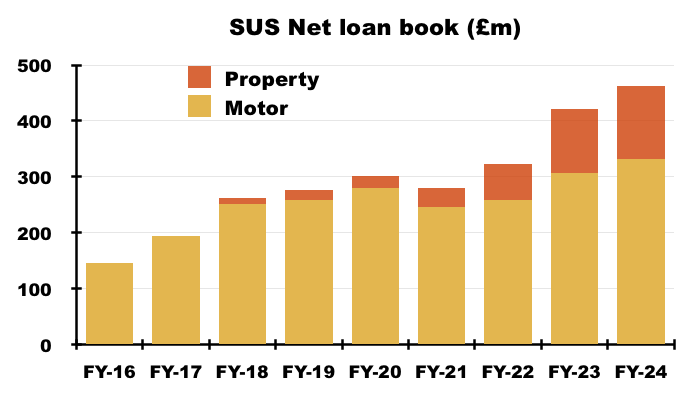
- The group’s net loan book advanced 10%, or £43m, to £463m during this FY, spread between an 8% advance to the motor-finance book (see Advantage Finance: loan sizes and rates) and a 15% advance to the property-finance book (see Aspen Bridging).
- The larger loan books were funded by greater debt, which during this FY expanded 15% to £224m (see Financials: cash flow and debt) to leave the group’s net asset value (NAV) £9m/4% higher at £234m — equivalent to £19.27 per share and a fresh NAV record:
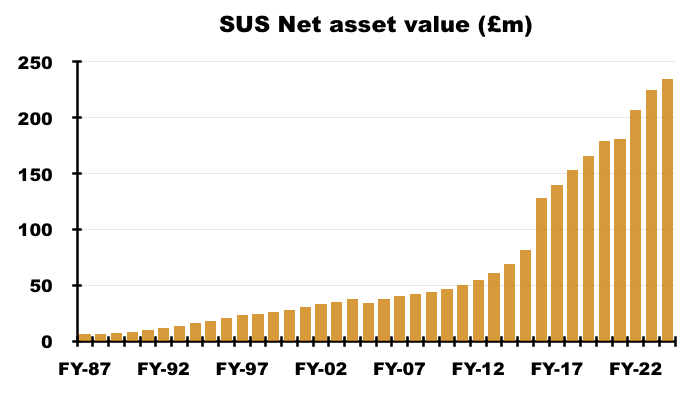
- The £234m NAV exceeds the £219m market cap (see Valuation).
- February’s cut to the second interim dividend may have already hinted the final payout would not be maintained.
- This FY revealed a 17% final-divided reduction as SUS bemoaned higher wage inflation, higher debt costs and higher taxes:
“Whilst recognising its primary responsibilities to its shareholders,S&U has always sought to balance the interests of all its stakeholders. This year’s fall in profit together with our wish to protect our loyal staff from recent increases in the cost of living has made this a particularly delicate one this year.
Thus, except for senior directors, average salaries this year have matched the rate of inflation, with more for living wage earners. Higher base interest rates have cost the Group an additional £8m this year, and our incoherent Government have raised the rate of corporation tax by nearly a third.
Taking all this into account, subject to the approval of shareholders at our AGM on 6 June, the board proposes a final dividend of 50p per ordinary share (2023: 60p).”
- The 17% final-dividend reduction left the FY dividend down 10% at 120p per share:
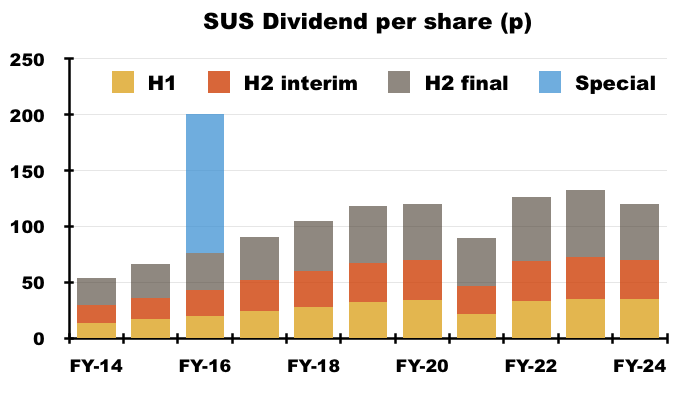
- Prior to the pandemic, SUS had not cut its annual dividend since 1987:
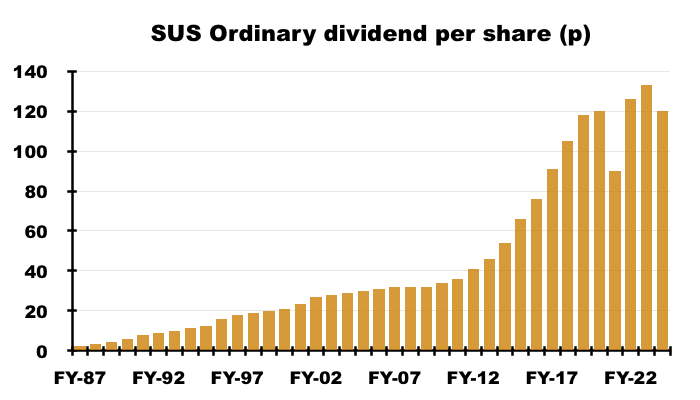
- Such an illustrious payout record suggests the aforementioned “headwinds” that have cut this FY’s dividend are unprecedented.
- This FY’s disappointing performance has extended into FY 2025. June’s trading update admitted Q1 2025 profit had dropped 34% while August’s trading update warned of motor-finance repayments sliding to 87% of due (see June and August trading updates).
Advantage Finance: loan sizes and rates
- SUS describes the customers of Advantage Finance as ‘non-prime’ and this FY outlined their typical circumstances:
“This long experience has enabled Advantage to gain a significant understanding of the kind of simple hire purchase motor finance suitable for customers in lower and middle-income groups. Although decent, hardworking and well intentioned, some of these customers may have impaired credit records, which have seen them in the past unable to access rigid and inflexible “mainstream” finance products.”
- Advantage has operated since 1999 and attracts customers for used-car loans via competitive rates and excellent customer service. Customers are acquired mostly through car dealers and finance brokers, and often receive their loans on the day of their application.
- However, Advantage’s “experienced, sensitive and sophisticated under-writing” does limit the number of successful applications. Advantage now receives more than 2 million applications a year, from which only 21,565 loans were awarded during this FY (see Advantage Finance: loan volumes and first payments).
- Advantage’s website cites a representative APR of 33.87%:

- The representative example indicates borrowing £8.0k at a flat 17% a year over 54 months leads to interest of £6.1k and a total repayable of £14.6k including a £325 acceptance fee and a £200 vehicle-purchase fee.
- Loan sizes have increased over time. The average amount borrowed by Advantage’s customers to buy a used car surpassed £5k during FY 2012, £6k during FY 2015, £7k during FY 2022 and £8k during this FY:

- The greater loan size reflects the greater price of a used car. The comparable FY claimed the wider used-car market had seen average prices almost double to £17.6k between 2011 and 2022…
- …although this FY quietly noted a “used-car price correction” without giving specific details.
- Rising car prices should be positive for Advantage; customers ought to borrow more money, pay more interest and (in theory) provide SUS (and shareholders) with more profit.
- Customers are ranked into different tiers based on their likelihood to repay, and management said during the preceding H1 webinar that SUS had concentrated on tier B/C/D customers who “give us a higher margin“:
[H1 2024] “The tier mix is very stable. The average… credit score is very stable as well. And we have been spending this year making small increases and improvements in terms of the mid-quality customers, the B to D categories that give us a higher margin, which has helped us to manage our overall interest rate margin moving forward. “
- This FY confirmed a slight shift away the top-tier A+/A customers.
- The preceding FY indicated between 600 and 700 A+/A customers were recruited every month:

- But this FY showed Advantage recruiting approximately 550 monthly A+/A customers:

- The two charts suggest the monthly numbers of B/C/D customers did not change dramatically during this FY, although perhaps the number of bottom-tier-E customers did increase a fraction.
- The shift away from A+/A towards B/C/D/E increased the average (flat per annum) rate the borrowers paid during this FY from 16.3% to 16.9%.
- For perspective, the average rate paid between FYs 2016 and FY 2021 was at least 17%, while the 16.3% charged during FYs 2022 and 2023 was the lowest since at least FY 2012:
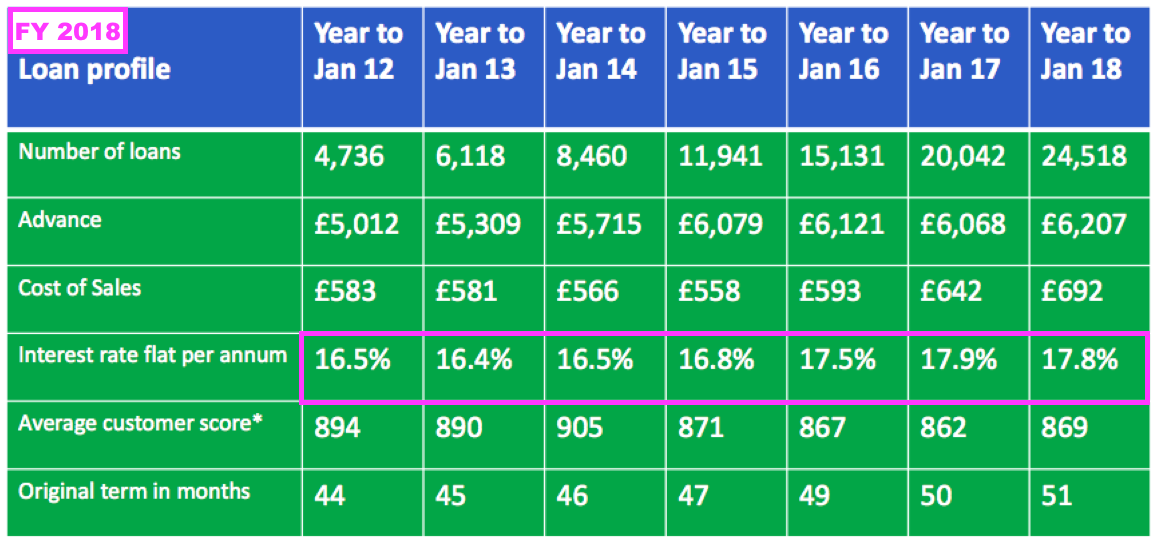
- The duration of the typical loan remains longer than historical norms. The 54 months for this FY compares to 50 for FY 2017 and 44 for FY 2012.
- I speculate the lengthier repayment duration reflects the aforementioned higher cost of used cars as customer budgets generally reach a c£275 per month repayment ceiling.
Advantage Finance: loan volumes and first payments
- The 21,565 new motor loans issued during this FY were 10% down versus the comparable FY, but were nonetheless “on budget” given the “the need for a cautious approach in a difficult macro economy“:
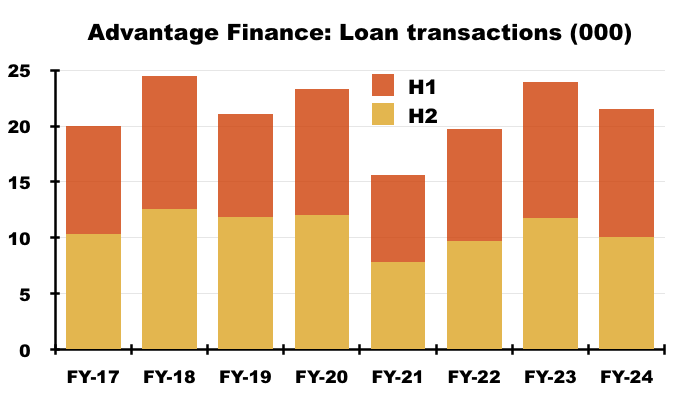
- This FY witnessed 53% of loans issued during H2 (11,493), the strongest H2 bias since at least FY 2017.
- The 21,565 new loans issued during this FY were offset by 20,086 accounts closed due to completed repayments, voluntary terminations or the commencement of legal proceedings:
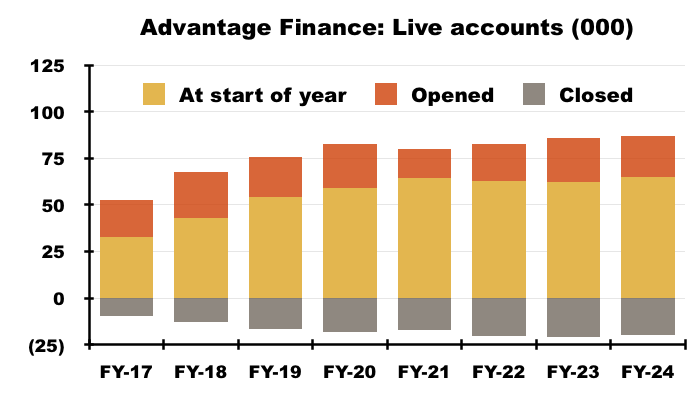
- The account openings and closures left total ‘live’ accounts 1,479 higher at a record 66,702:

- The higher 16.9% average (flat per annum) rate with account numbers surpassing 66,000 helped push Advantage’s FY revenue to a record £98m:

- Emphasising how rapid Advantage has grown, H2 revenue of £51m exceeded the division’s FY 2016 revenue of £45m.
- The aforementioned higher loan sizes translated into revenue per account increasing to nearly £1.5k (the highest since FY 2018), with the average loan outstanding before impairments now at a new £6.6k high and the average loan outstanding after impairments at a new £5.0k high.
- The aforementioned 2 million-plus unique applications during this FY was lower than the 2.5 million cited during the comparable FY, but was double the 1 million cited for FY 2019.
- The preceding H1 webinar revealed a “fairly consistent” 30-35% acceptance application rate that helped “demonstrate the rigour of Advantage’s underwriting and affordability checks”.
- But then converting only 3% or so of accepted applications into actual loans — say, 2 million applications reduced to 650,000 successful applications converted then into 20,000 actual loans — is influenced by what management has claimed to be “digital tyre kickers”.
- 90% of Advantage’s loans continue to be sourced through brokers.
- Cost of sales per loan increased 6% to £961:

- Management’s FY webinar revealed the bulk of the £961 was paid as commissions:
“Cost of sales were £961 in the latest year. For information, about £700 of that is introduced commission, which is a variable cost that goes straight to the broker. Other costs of sales are consumer credit referencing and our data costs.”
- Cost of sales per loan at £961 equated to 11.8% of the £8.2k average loan and remains below the proportion witnessed during FYs 2020, 2021 and 2022.
- Perhaps reflecting the aforementioned shift to higher margin B/C/D-tier customers, cost of sales absorbed 21% of motor-finance revenue during this FY — a welcome reduction following the 24% registered during the comparable FY:
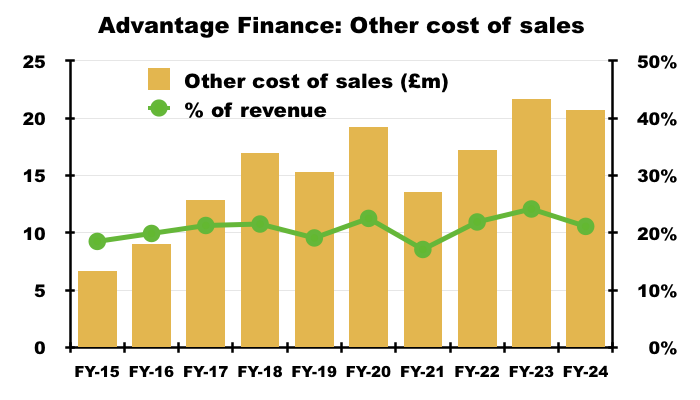
- SUS’s first-payment chart showed an alarming pandemic-like deterioration during Q4 (blue line, left axis):
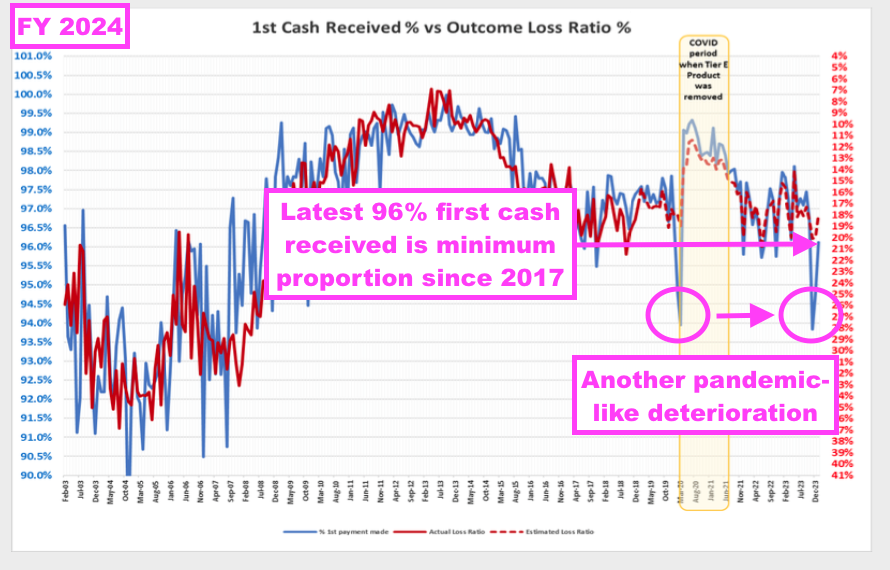
- The first-payment proportion plunging to 94% during Q4 was referred to as only a “blip” during management’s FY webinar:
“Towards the right of the chart we have got a couple of blips. So the first blip was just at the start of the pandemic when people panicked a bit and didn’t pay their first payment on time. We have also had a blip at Christmas this year, which happily for us has recovered a bit in January but we continue to monitor that as we go.“
- I can only presume the “blip” was due to the aforementioned Q4 “headwinds” of “poor consumer confidence, continuing high interest rates, cost of living pressures and regulation“.
- The proportion rebounding to 96% by January is reassuring, but 96% has typically been the minimum first-payment level (pandemic aside) since late 2017.
- The proportion of borrowers making their first payments on time has shown to correlate inversely to the proportion of loans that ultimately suffer losses (red line, right axis).
- I await the forthcoming H1 2025 to supply a revised version of this first-payment chart. The adverse updates during June and August suggest the blue line may have deteriorated (see June and August trading updates).
Advantage Finance: collections and estimated repayments
- SUS reported collections during this FY at 92.1% despite a “temporary hiatus” during Q4:
“Our repayments are one indicator of our historically good relations with our valued customers. Thus, despite what we anticipate to be a temporary hiatus in the last quarter, Advantage live monthly repayments as percent of due finished at 92.1% for the year (2023: 93.6%).
- Collections at 92.1% of due compares reasonably well to the 93.6% for FY 2023, 93.2% for FY 2022, 83.3% for (pandemic-blighted) FY 2021 and 93.5% for FY 2020.
- Mind you, collections were 94.1% of due during H1 and SUS’s chart shows collections were consistently below budget at an approximate 90% average during H2:
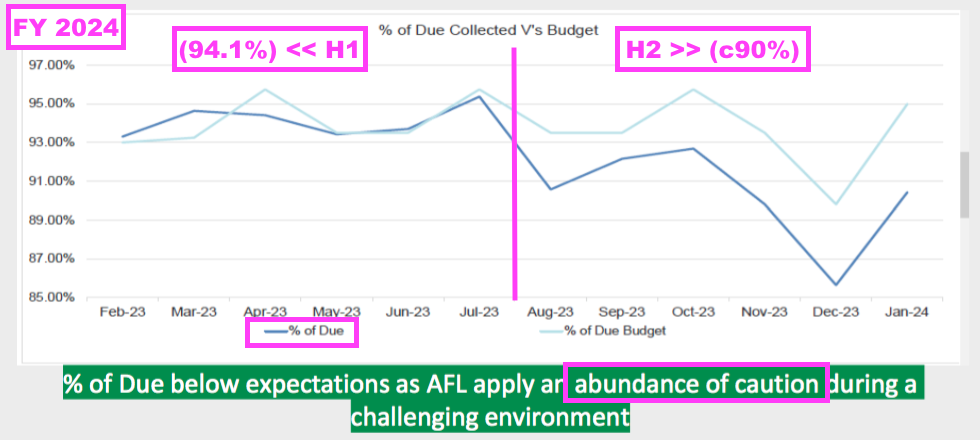
- The “temporary hiatus” of collections reflected regulatory intervention and SUS applying an “abundance of caution” with its repayment processes (see Regulation: SUS response):
“In response to ongoing concerns regarding the cost of living and its declared objective to “deliver quantifiable consumer benefits,” the FCA has launched comprehensive inquiries across the industry, affecting approximately two-thirds of non-prime motor finance companies. In anticipation of the findings, Advantage has consented to specific limitations on its repayment processes. These modifications have temporarily influenced monthly repayments and recovery efforts.”
- Trading updates issued during June and August admitted Advantage’s collections had since deteriorated to 87% of due (see June and August trading updates).
- Given the faltering percentage of due-collections, total cash collections ran behind budget throughout H2:
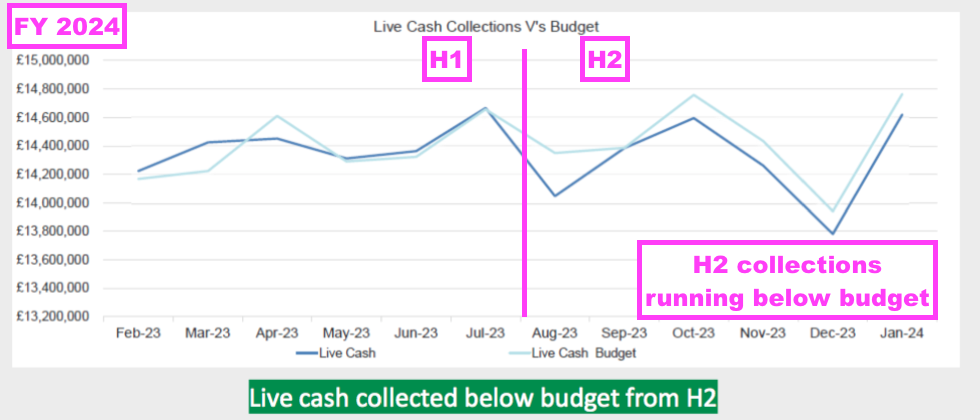
- At least the number of bad debts incurred and the number of voluntary terminations handled for this FY were better than budget:

- Advantage’s collections, settlements and recoveries for this FY amounted to £225m, up 4% on the comparable FY:

- However, that 4% advance was less than the 8% increase to Advantage’s loan book.
- As such, collections, settlements and recoveries as a proportion of the gross loan book (i.e. before impairments) and the net loan book (i.e. after impairments) were 57% and 75% respectively, and on a par with the pandemic lows of FY 2021:
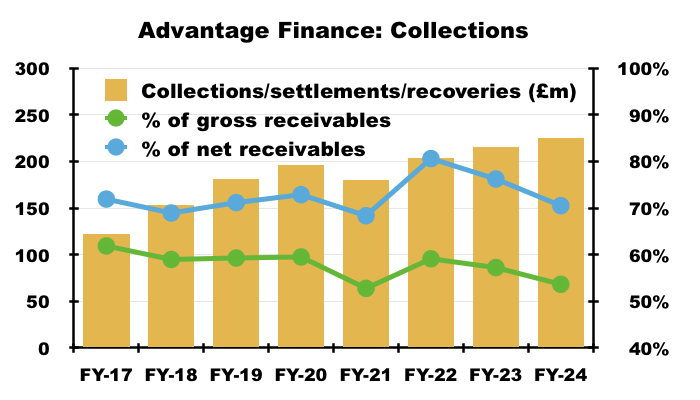
- Collections, settlements and recoveries becoming a smaller proportion of the loan book may suggest Advantage’s borrowers are becoming more reluctant to repay.
- Advantage’s estimates of future repayments have declined to a worrying new low:
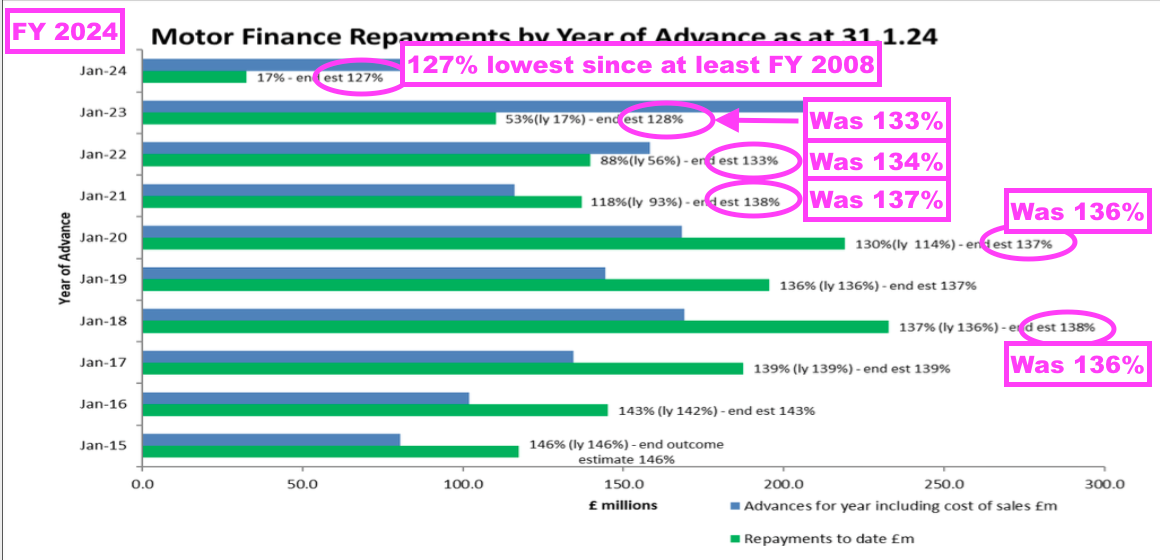
- SUS expects customers will eventually repay 127% of the loans advanced during this FY, which will be the lowest payback percentage since at least FY 2008 if the estimate proves accurate.
- For the loans advanced during the comparable FY, the expected repayment has been reduced from 133% to 128%.
- Collecting 127% of the original loan is some way off the 150%-plus collected for money lent between FYs 2010 and 2014:
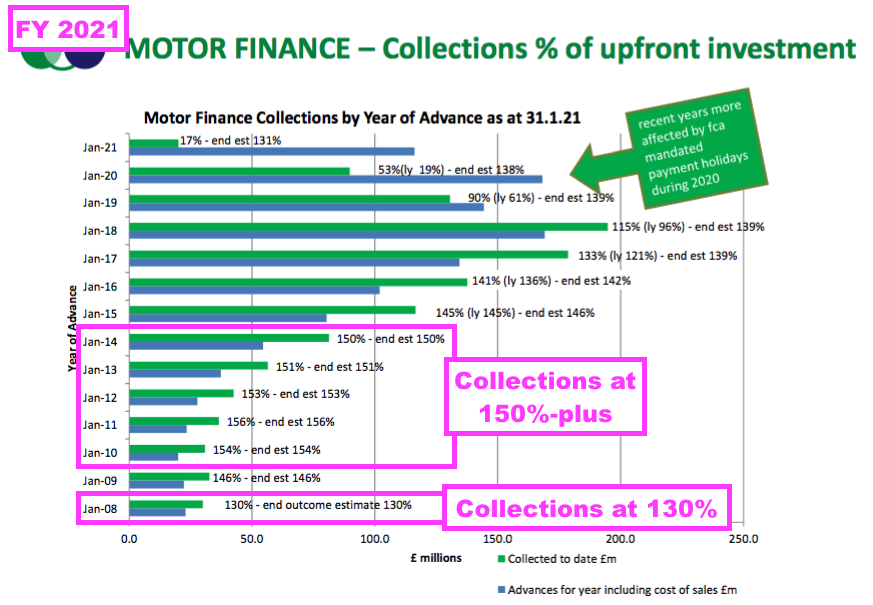
- Note that for (pandemic-blighted) FY 2021, SUS initially estimated a 131% payback for that year’s loans… which has since been uplifted to 138%.
- I am hopeful SUS is once again ‘under-promising’ with a 127% payback estimate for an ‘over-delivery’ during the next few years.
- That said, the introduction of a 127% payback estimate — below the 131% estimate made during the depths of the pandemic — provides further evidence the aforementioned “headwinds” are unprecedented.
Advantage Finance: up-to-date and overdue accounts
- The slower rate of repayments during H2 left only 74% of Advantage’s loans up-to-date at the end of this FY:
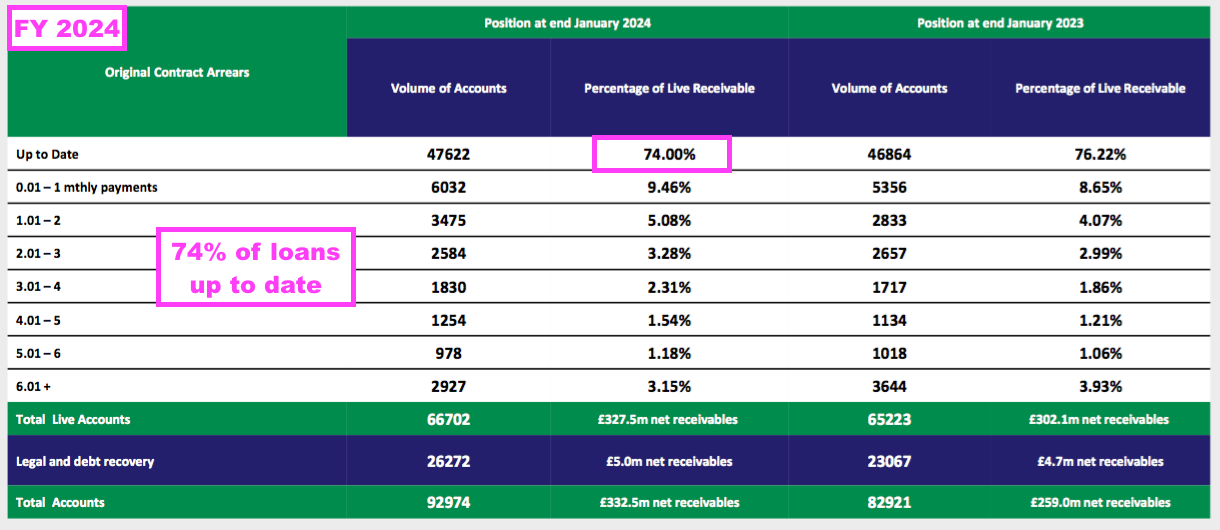
- The 74% compares to 79% for the preceding H1 and 76% for the comparable FY:
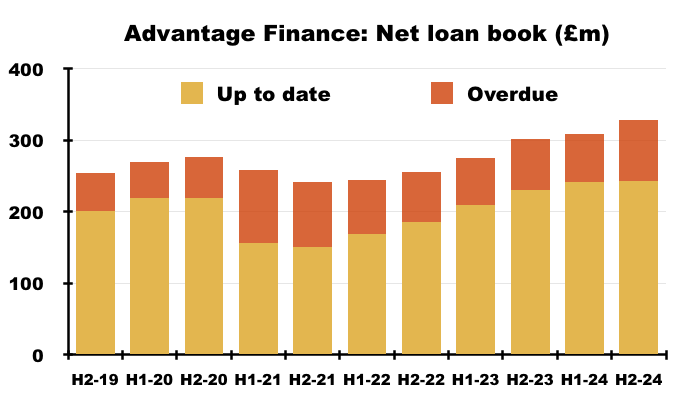
- However, the up-to-date 74% exceeds the 61% (H1 2021), 62% (FY 2021), 69% (H1 2022) and 73% (FY 2022) recorded during the pandemic.
- During the pandemic, approximately 20,000 Advantage customers enjoyed FCA-authorised payment holidays that lasted up to six months and a cut-off date of 31 July 2021.
- SUS deemed the payment-holiday customers as ‘overdue’ even if normal repayments were resumed.
- The FCA may arguably be authorising payment holidays once again — although this time the cessation of payments may last longer than six months and no cut-off date has been set (see Regulation: Borrowers in Financial Difficulty).
- Note that August’s trading update revealed just 69% of Advantage’s loans were up to date (see June and August trading updates).
- For perspective, the up-to-date proportion topped 80% during FYs 2017 and 2018, and reached a super 91% during FY 2016:
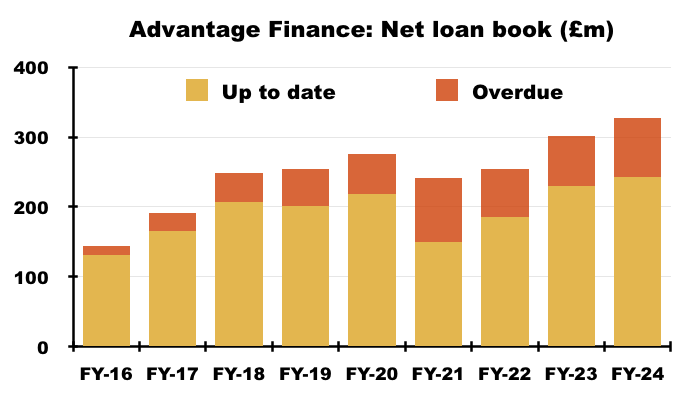
- This FY did not disclose any pandemic payment-holiday statistics.
- But 2,285 payment-holiday customers did close their accounts (one way or another) during the preceding H1, which suggested payment-holiday customers may have all vanished from the loan book by the end of FY 2025:
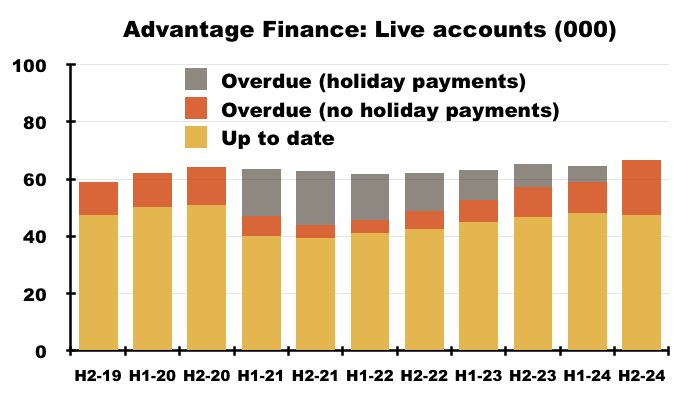
- The average net loan outstanding (i.e. after impairments) at overdue accounts continues to creep higher to match the average at up-to-date accounts:
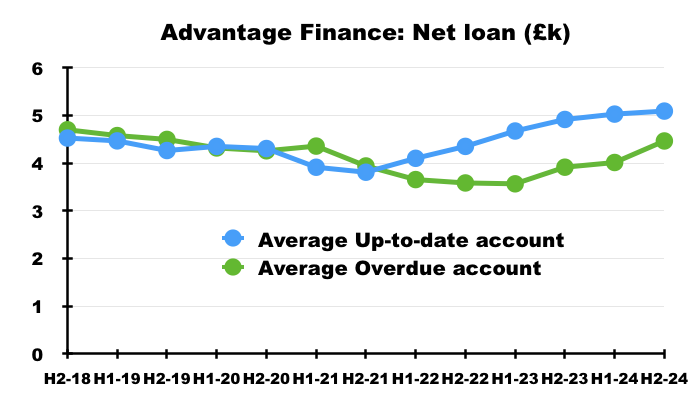
Advantage Finance: impairments
- SUS’s loan impairments are classified as:
- Stage 1, which reflects expected write-offs from up-to-date customers;
- Stage 2, which reflects expected write-offs from customers not in arrears but who are deemed “vulnerable” by factors such as “health, life events, resilience or capability” that create a greater credit risk, and;
- Stage 3, which reflects expected write-offs from customers one month or more in arrears.
- Advantage’s total impairment provision increased by £9m to £105m during this FY:

- Encouragingly perhaps, this FY’s split between Stage 1 (20%) and Stage 3 (78%) impairments were similar to the Stage 1 (21-22%) and Stage 3 (78-79%) splits witnessed for pre-pandemic FYs 2019 and 2020.
- Of the £292m lent to up-to-date Stage 1 borrowers, SUS reckoned £21m or 7% will not be repaid:
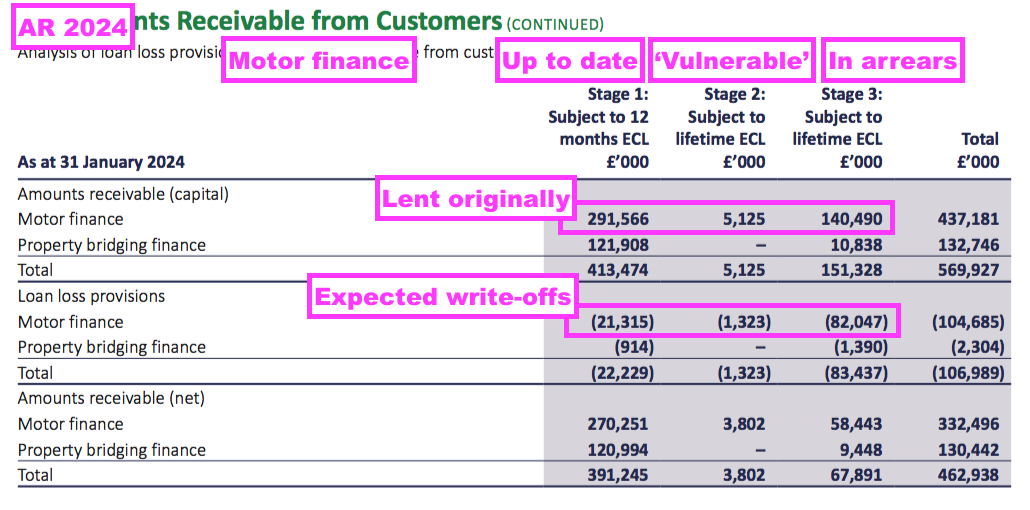
- Of the £140m lent to in-arrears Stage 3 borrowers, SUS reckoned £82m or 58% will not be repaid.
- The 7% and 58% broadly match the 9% and 60% proportions reported at the preceding FY.
- Lending a total £437m and impairing £105m means Advantage expects to receive 76p of capital for every £1 currently loaned.
- Charging the aforementioned 33.87% APR is therefore required to recoup the 24p of capital not repaid as well as earn an adequate return on the overall £1 lent.
- The total £105m impairment provision was equivalent to 24% of the overall £437m lent originally and still outstanding:
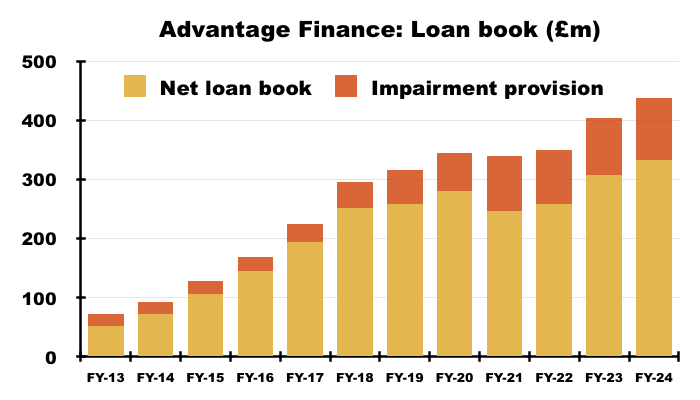
- The proportion for the preceding FY was also 24%, and for FYs 2021 and 2022 were 27% and 26% respectively.
- For pre-pandemic FYs 2019 and 2020, though, Advantage’s impairments ran at 18% of total money lent. But Advantage’s impairments did surpass 25% during FYs 2011, 2012 and 2013.
- I fear Advantage’s adverse collection trend (see Advantage Finance: collections and estimated repayments) is likely to inflate that 24% proportion.
- Indeed, Advantage’s impairment charge during this H2 was £16m versus only £7m for the preceding H1:
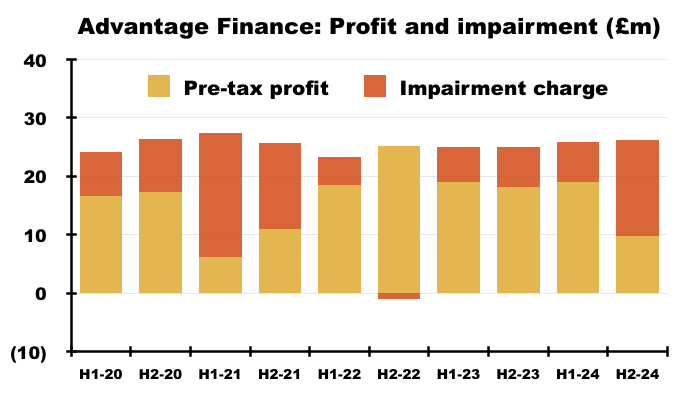
- Advantage’s gross loan book (i.e. before impairments) meanwhile increased by £28m during H2.
- If continued, impairing an extra £16m after lending an additional £28m will certainly lead to a gross loan book with much greater expected write-offs.
- This FY repeated the “macroeconomic overlays” that are employed within the impairment calculations:
“The macroeconomic overlay assessments for 31 January 2024 reflect that further to considering such external macroeconomic forecast data, management have judged that there is currently a more heightened risk of an adverse economic environment for our customers. To factor in such uncertainties, management has included an overlay for certain groups of assets to reflect this macroeconomic outlook, based on estimated unemployment and inflation levels in future periods.”
- Once again SUS said there was “currently a more heightened risk of an adverse economic environment”.
- Part of SUS’s impairment estimates are based on assuming inflation falls to 1% during early 2026:
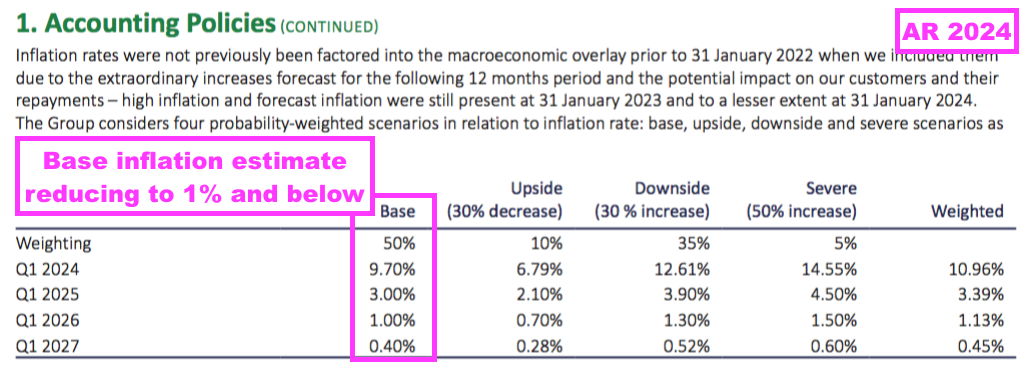
- SUS is not expecting used-car prices to decline during FY 2025:
“An overlay for used vehicle prices was also included at 31 January 2023 as we assumed at that point that these prices would fall by 13.5% after a large increase in the previous 12 months. As at 31 January 2024, we have not included an overlay for used vehicle prices as we assume that used vehicle prices will now remain stable after the anticipated large decrease in the previous 12 months.”
- Note that SUS will register an extra £3m impairment charge if used-car prices decline by 5%:
“If used car prices were assumed to fall by 5% instead, then this would result in an increase in loan loss provisions of £2,967,534.”
- The overlay assessments also include a £69m “trade value” estimate of vehicles in Stage 3 arrears:
“As stated in note 1.13 above, valuing these used vehicles secured under our hire purchase agreements is uncertain as the condition and mileage of the used vehicle are unknown. We estimate the trade value of collateral held at 31.1.24 for motor finance loans currently in stage 3 was £68.8m (2023: £64.5m) – these estimated values are stated before taking into account recovery and disposal costs.
- The £58m Stage 3 net loan book was less than that £69m “trade value”, suggesting SUS could (if need be) repossess the Stage 3 vehicles (for £69m) and perhaps recoup the their Stage 3 loan-book value (of £58m) after costs.
Aspen Bridging
- Established at the start of FY 2018, Aspen offers property-bridging loans for small/individual property developers.
- This FY outlined the division’s attractions to borrowers:
“Mainstream” banks, including the newer “challengers”, continue to lack the speed, flexibility and appetite to furnish the smaller, short-term loans in which Aspen specialises. Recent consolidation and instability in the challenger banking sector is evidence of this and again shows that, technology, speed and a quality bespoke service – as well as price – are what give smaller entrants like Aspen their competitive edge.”
- The subsidiary’s profitability is supported by conservative lending to low-risk “experienced” customers:
“Aspen values its security properties very conservatively and keeps gross LTVs to an average 70% and the business now only considers experienced borrowers from the top three quality bands.“
- The conservative lending is underlined by Aspen visiting every property…
“Every property upon which Aspen lends for security is personally visited by a member of the team.”
- …which this FY claimed was unique within the industry:
“Increased margins, steady LTV’s and sensible valuations approach with our USP of visiting all projects.”
- This FY revealed “most” of Aspen’s loans were secured on properties within south east England, and these case studies give a flavour of the transactions involved:
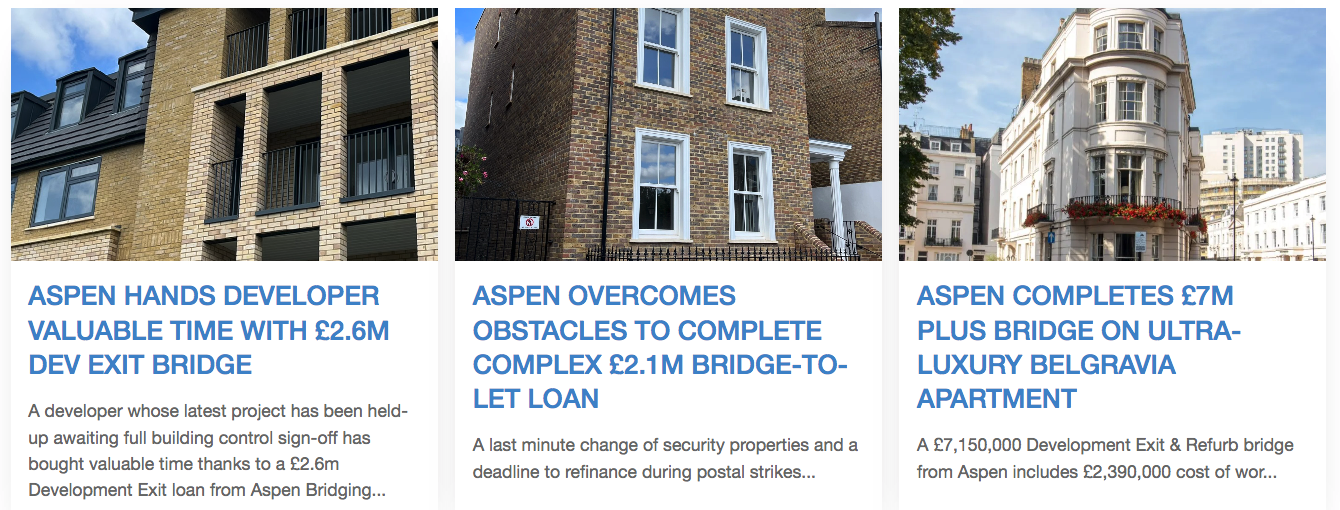
- Lending appears to have loosened during H2. The preceding H1 showed an average 65% gross loan-to-value, the lowest since Aspen’s formation…
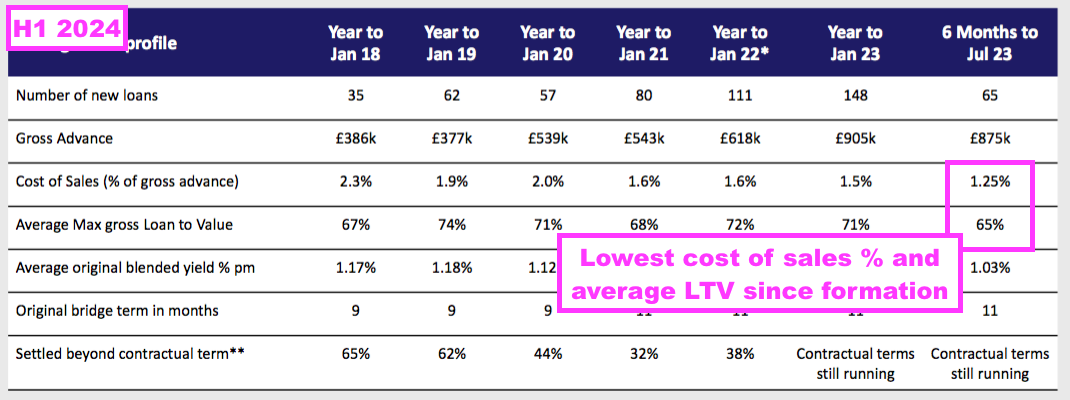
- …but this FY showed the average gross loan-to-value rising to a more normal 69%:
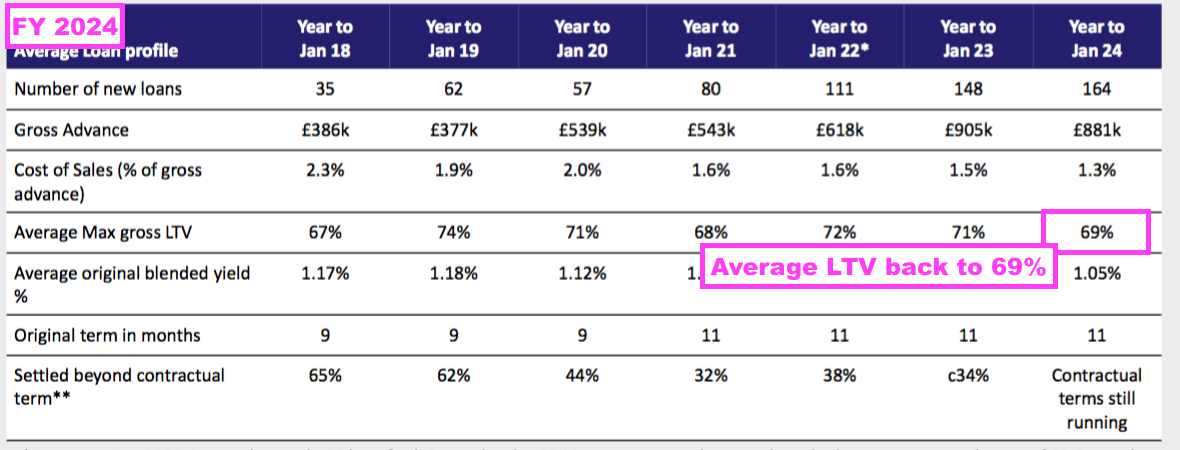
- Aspen’s rate card says developers borrowing against residential properties pay a flat monthly interest rate of 0.94% on a 75% loan-to-value arrangement.
- For perspective, my FY 2022 review had highlighted 0.69% monthly interest on a 70% loan-to-value arrangement.
- This FY talked of “excellent” progress that may continue into FY 2025 despite a “subdued” housing market:
“Aspen’s has continued to make excellent but careful progress in a fluctuating and still subdued housing market, affected by continued high interest rates and persistently high mortgage costs as a proportion of average incomes. Both are expected to improve in 2024.
…
[D]emand from good borrowers remains high and hence Aspen plans a slightly accelerated rate of growth this year“
- June and August’s trading updates confirmed positive progress was achieved during H1 2025 (see June and August trading updates).
- 165 customers were advanced an average £881k for 11 months during this FY.
- The £881k average reflected the “experienced” borrowers and remains much higher than the average £618k or less (excluding CBILS) advanced to perhaps less experienced borrowers up to FY 2022:
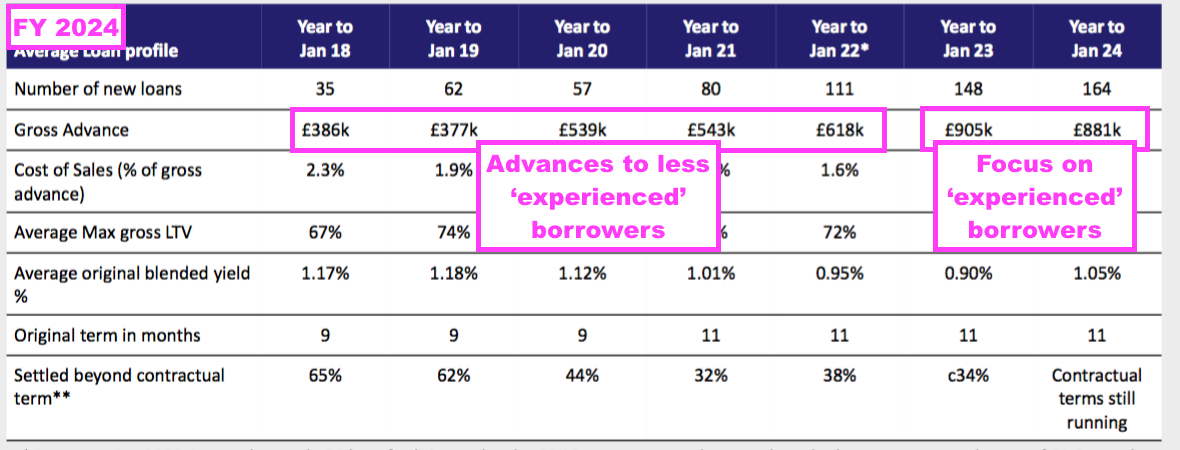
- 165 clients receiving an average £881k gave a total £145m gross advance:

- Lending was biased towards H2, with 99 borrowers taking on £88m versus H1’s 65 borrowers taking on £57m.
- The total FY £145m advance allowed Aspen’s net loan book to expand by 15% to £130m:
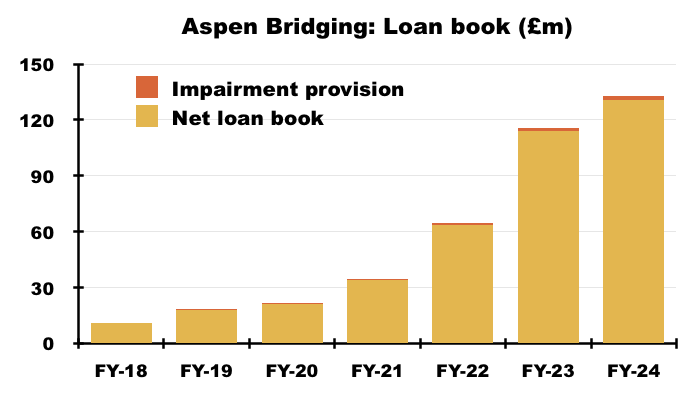
- Aspen’s FY net advances (i.e. after retentions) of £126m equalled collections of £126m:
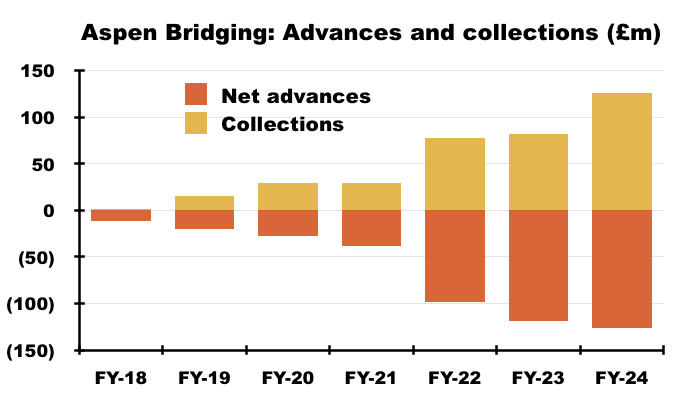
- Boosting this FY’s collections were ‘repayments beyond term’, which surged 77% to £34m:
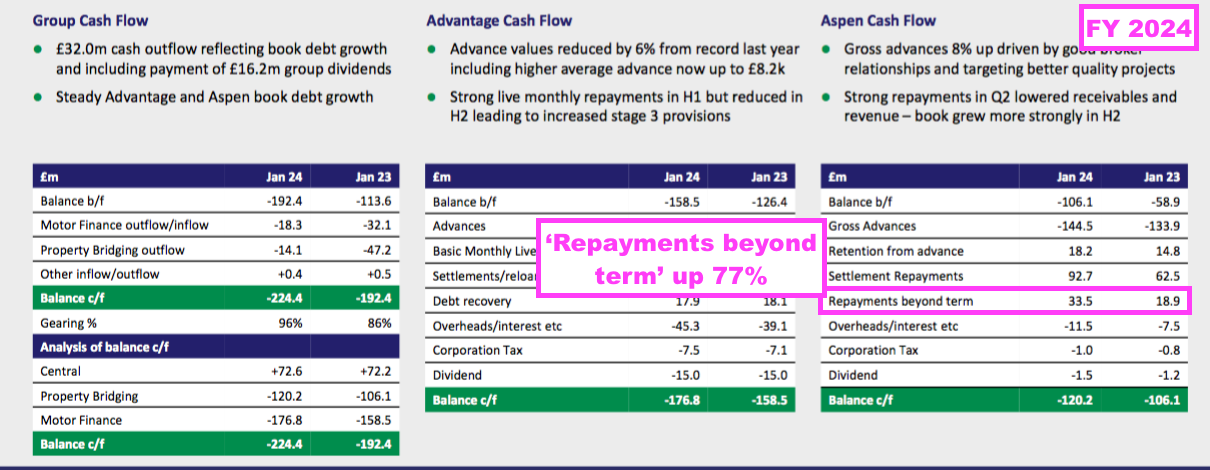
- Greater ‘repayments beyond term’ suggest not every Aspen borrower completed their development on time. Such repayments have bolstered standard repayments by a total 34% since Aspen’s formation:
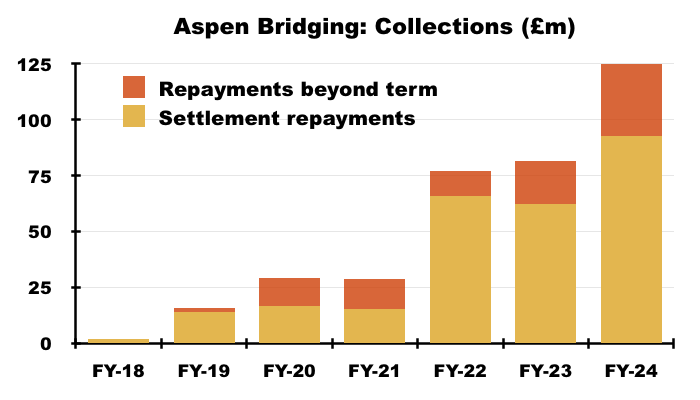
- Of the aggregate 681 loans advanced by Aspen since the subsidiary’s formation, 518 have been repaid and only 15 of the remaining 163 are “in default” — versus 12 of 141 for the comparable FY.
- This FY noted four properties were “in repossession” at the year end, for which “recovery is in progress and adequate provision has been made“. The comparable FY reported only one repossession.
- The 15 defaulters are categorised as Stage 3 borrowers, and although the £11m Stage 3 property loans are greater than the £7m reported at the comparable FY…
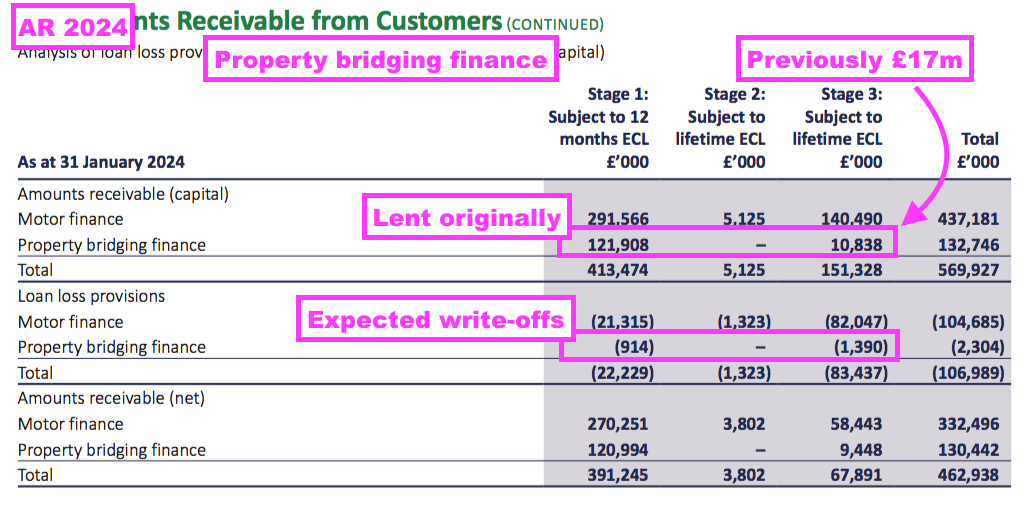
- …they are encouragingly less than the £17m reported at the preceding H1.
- This FY implied the £11m lent originally on these Stage 3 properties would be recouped if the properties were sold for their estimated £15m market value:
“The estimated value of first charge secured properties held under our bridging loan facility agreements at 31.1.24 is £199.6m (2023: £184.7m). This includes £15.3m estimated value of properties secured which is held for loan agreements currently in Stage 3 (2023: £13.4m).”
- The same text revealed the market value of all Aspen’s properties was £200m, which equates to a 65% loan-to-value given Aspen’s net loan book finished this FY at £130m.
- Aspen’s enlarged loan book pushed FY revenue 34% higher to £17m:
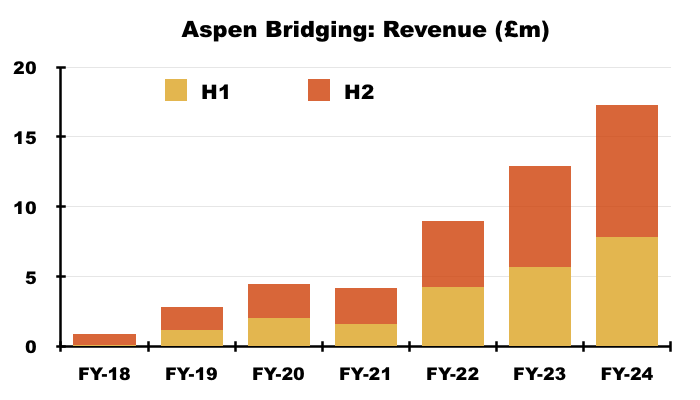
- Aspen’s impairment provision increased by 48% during this FY to £2.3m, but remains tiny versus the £133m gross loan book:

- Cost of sales (mostly broker fees) at a reported 1.3% of the average advance for this FY was the lowest since Aspen’s formation:
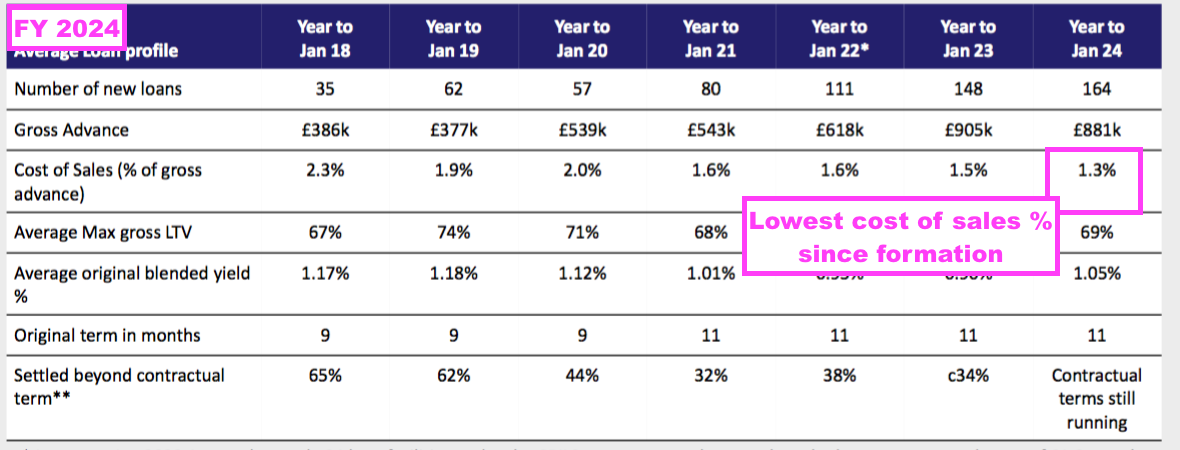
- Aspen’s cost of sales were a welcome 12% of revenue (£2.1m/£17m) versus 14-17% between FYs 2020 and 2023.
- The low cost of sales and low impairments allowed Aspen’s FY profit to reach £4.8m:
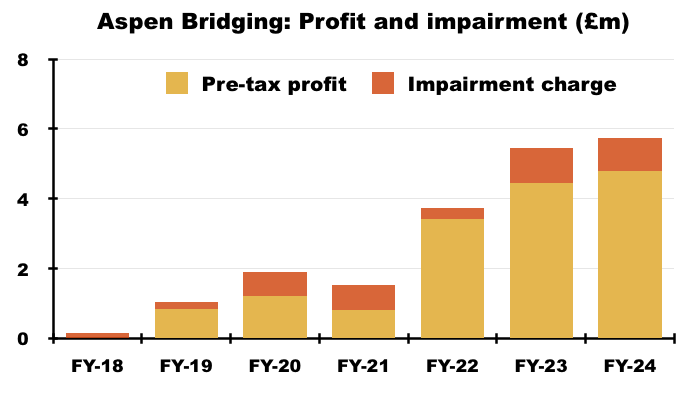
- Although Aspen’s loan book represented 28% of SUS’s entire lending (after impairment provisions)…

- …Aspen’s profit represented 14% of SUS’s entire profit:
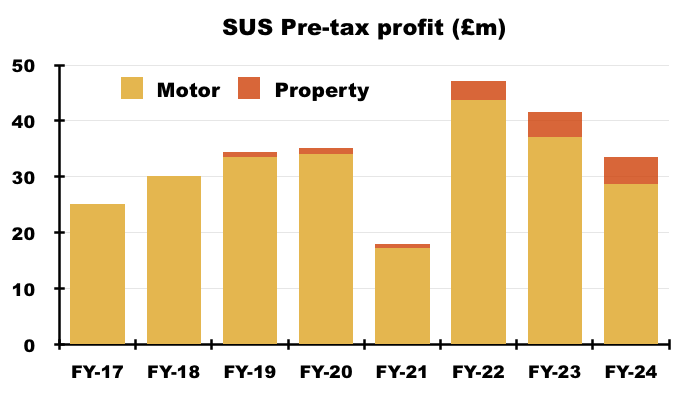
- The implication therefore is Aspen currently generates much lower returns on its loans than Advantage, although the use of debt within the subsidiaries must also be considered (see Financials: returns on assets and equity).
- This FY anticipated Aspen would enjoy “further steady and sustainable growth” during FY 2025, and “great things” further out:
“Since its launch in 2017, Aspen has more than met S&U’s expectations, and great things are expected of it in the future.”
- Aspen’s blog reveals the aim of taking cumulative lending from £500m to £1 billion “in the next couple of years“:
[Aspen website] “Jack Coombs, Managing Director at Aspen Bridging, said: “The business has successfully grown these last few years which resulted in us recently surpassing the £500m lending landmark from when the business was founded in 2017.
As we look upwards to £1bn worth of lending, which we are looking to realise in the next couple of years, we have to invest in the business and our core teams. These promotions are all well-deserved and we are excited about the positive contribution they will make to the business going forwards.” “
Boardroom
- SUS is run by the Coombs family, and lead executives Anthony and Graham Coombs are grandsons of founder Clifford Coombs and have worked at the business since the mid-1970s:
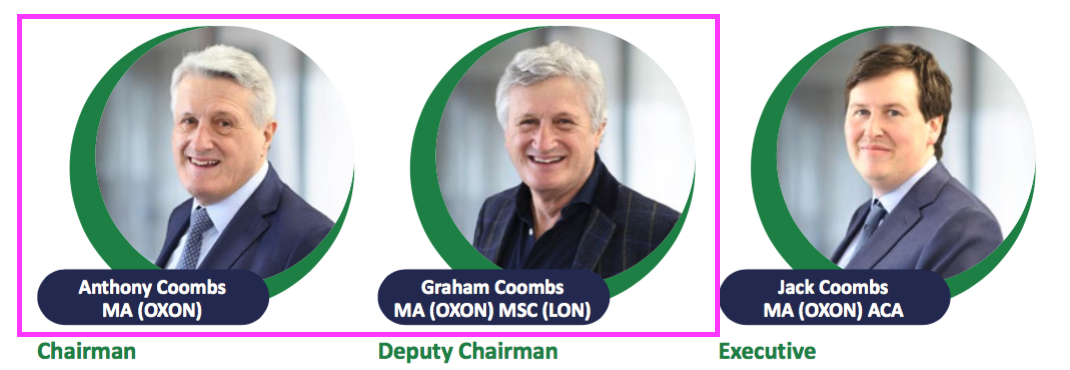
- The Coombs family controls at least 44% of the shares and it’s this owner-managed boardroom that has delivered the illustrious dividend since 1987.
- Various appointments do suggest the Coombs family prefers Aspen to Advantage.
- Jack Coombs for instance is a main SUS board executive and an Aspen director. At 37 years old, Jack Coombs may well become the lead SUS/Coombs director when his 71-year-old cousins Anthony and Graham decide to retire.
- Richard Coombs — the son of Graham Coombs — joined Aspen last year.
- I note SUS’s head office and Aspen are both located in Solihull while Advantage is based in Grimsby.
- Aspen may have much greater returns on equity, too (see Financials: returns on assets and equity).
- From what I can tell, Anthony and Graham Coombs act as ‘capital allocators’ within S&U.
- Dividends are paid by Advantage and Aspen to the parent company, whereby Anthony and Graham can then decide to:
- Redeploy the money back into Advantage and/or Aspen;
- Return the money to shareholders as a dividend, or;
- Reduce debt.
- Despite the shares trading below book value (see Valuation), management’s FY webinar confirmed buybacks are not being considered:
“We have no plans to buy the preference shares back currently and also have no plans to seek authority to buy back our main ordinary shares which would be likely to reduce further the already limited free float. We have previously deployed capital to grow our businesses where there are sensible potential forecast returns and pay regular dividends and that is still our current plan.”
- Management’s FY webinar also dismissed ideas of selling Advantage to focus on Aspen:
“We have no plans to sell Advantage. We believe it is an excellent business which can emerge strongly from the current uncertainties caused mainly by regulatory activity in the sector.”
- Advantage does seem to be an ‘external’ investment for SUS.
- This Advantage blog post seemingly refers to the division’s founders approaching SUS for start-up funds:
[Advantage website] “Three founding members, with one shared goal: putting customers first while providing an opportunity to purchase and own their own motor vehicle without the aggressive sales approach. With this goal in mind, there was a clear and obvious investment choice – S&U. S&U has always offered and looked for a way to support the lesser served section of society, so when the three founding members shared the goal, the Coombs family knew they were the right people to lead them into a new area of finance for the group.”
- This FY welcomed Advantage’s new boss Karl Werner…
“[SUS has] great pleasure in welcoming Karl Werner as the new Chief Executive of Advantage. Karl has impressed enormously in the few months he has been with us, and his long experience of the finance industry and its regulation, particularly at MotoNovo and Aldermore Bank will make him a distinguished successor to Graham Wheeler.”
- …who became Advantage’s boss the day after this FY ended and therefore has yet to make a real impact on the division’s progress.
- Mr Werner’s first task at Advantage is to oversee the FCA’s new Borrowers in Financial Difficulty rules (see Regulation: Borrowers in Financial Difficulty) and the FCA’s new Consumer Duty regime (see Regulation: Consumer Duty).
- Mr Werner has encouragingly worked within a group much larger than SUS. His former employer, MotoNovo Finance, is part of Aldermore Bank, which is part of FirstRand Group. MotoNovo’s FY 2023 accounts showed customer lending of more than £4b.
- Although Mr Werner has not joined SUS’s main board, his predecessor, Graham Wheeler, only joined SUS’s main board a year after becoming Advantage’s boss.
- Mr Wheeler is now a non-executive director, and matches the other non-execs with a zero shareholding:
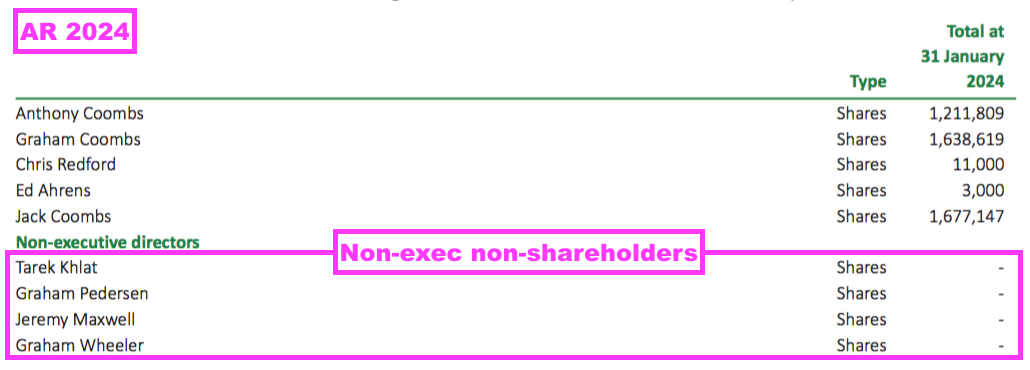
Financials: cash flow and debt
- This FY witnessed Advantage report an £18m cash outflow after lending £176m, collecting £225m, expensing £53m and paying £15m as dividends to the parent company:
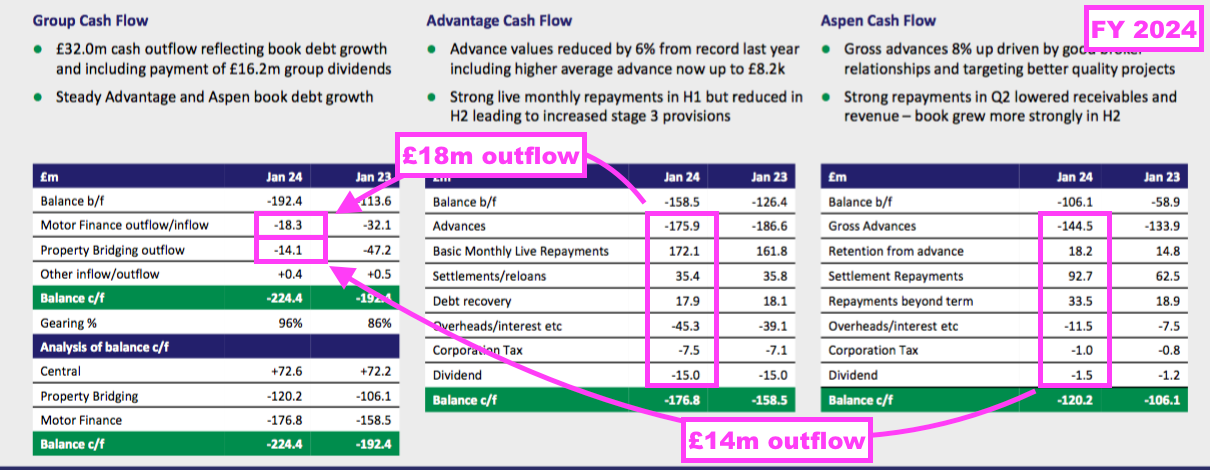
- Aspen meanwhile reported an FY £14m cash outflow after lending a net £126m, collecting £126m, expensing £13m and paying £2m as dividends to the parent company.
- Advantage’s FY outflow surpassed Aspen’s FY outflow for the first time since FY 2020:
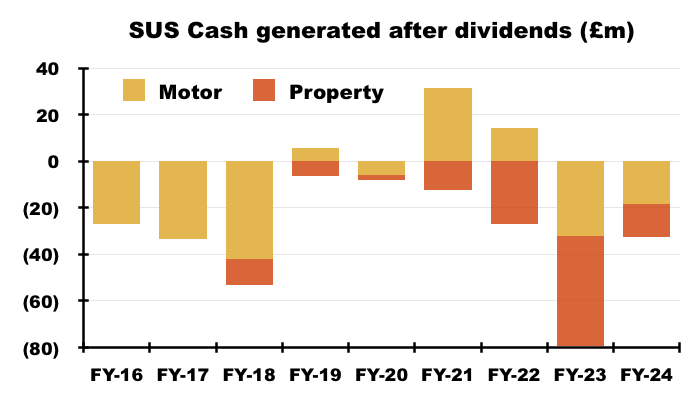
- But Aspen has absorbed the bulk of SUS’s funding over time. During the last five years for example, SUS has taken on additional debt of £116m, of which Advantage received approximately £12m while Aspen received approximately £104m (see Financials: returns on assets and equity).
- The dividends paid by Advantage and Aspen to the parent company do not always tally exactly with the dividends paid to SUS shareholders:
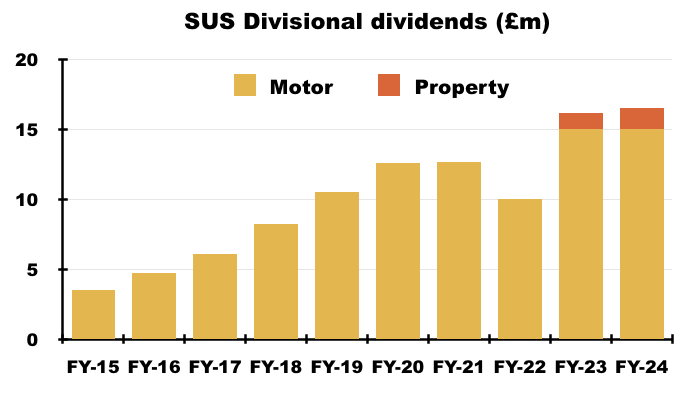
- During this FY and the comparable FY, aggregate dividends paid by Advantage and Aspen were £1m greater than the aggregate paid by SUS to shareholders:
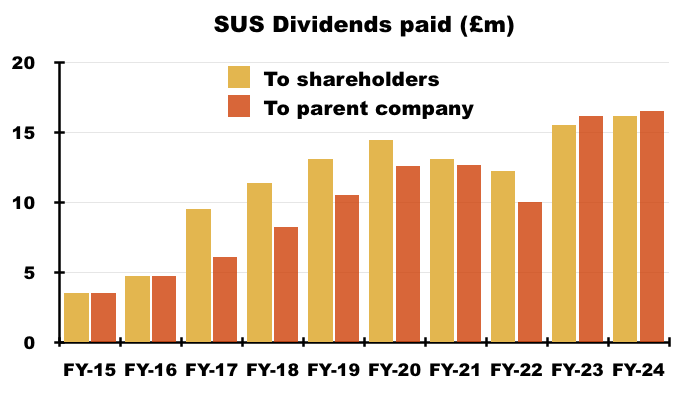
- Mind you, between FYs 2017 and 2022, SUS paid shareholders an aggregate £14m more than was paid by Advantage and Aspen to the parent company.
- The extra £32m required during this FY to fund operations/dividends at Advantage (£18m) and Aspen (£14m) was covered by additional borrowings.
- Net debt increased by £32m to £224m and remains under control; borrowings are more than twice covered by the £463m lent to customers (after impairments):
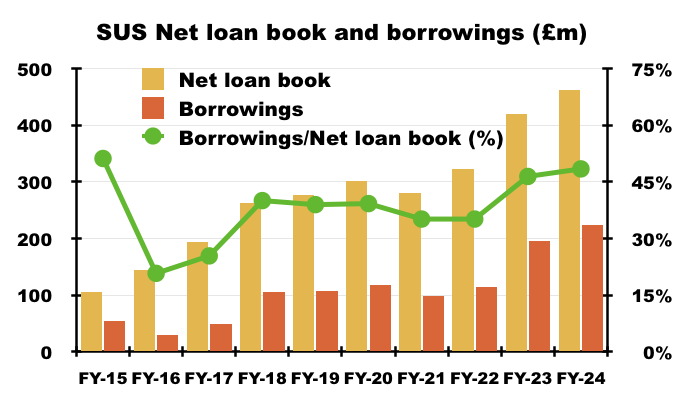
- Bank interest paid during this FY was £15m, implying SUS’s average £210m FY borrowings incurred interest at approximately 7.1%.
- H2 interest was approximately £8m, implying SUS’s average £205m H2 borrowings incurred interest at 8.0%.
- 8.0% compares to 4.8% for the comparable FY and 3.4% for FY 2022.
- This FY confirmed an 8% borrowing rate:
“The average effective interest rate on financial assets of the Group at 31 January 2024 was estimated to be 26% (2023: 25%). The average effective interest rate of financial liabilities of the Group at 31 January 2024 was estimated to be 8% (2023: 6%).“
- This FY also admitted “interest rates remained higher than anticipated”.
- SUS still does not disclose the exact rates payable on its debt facilities, which is very poor form for a main-market company:
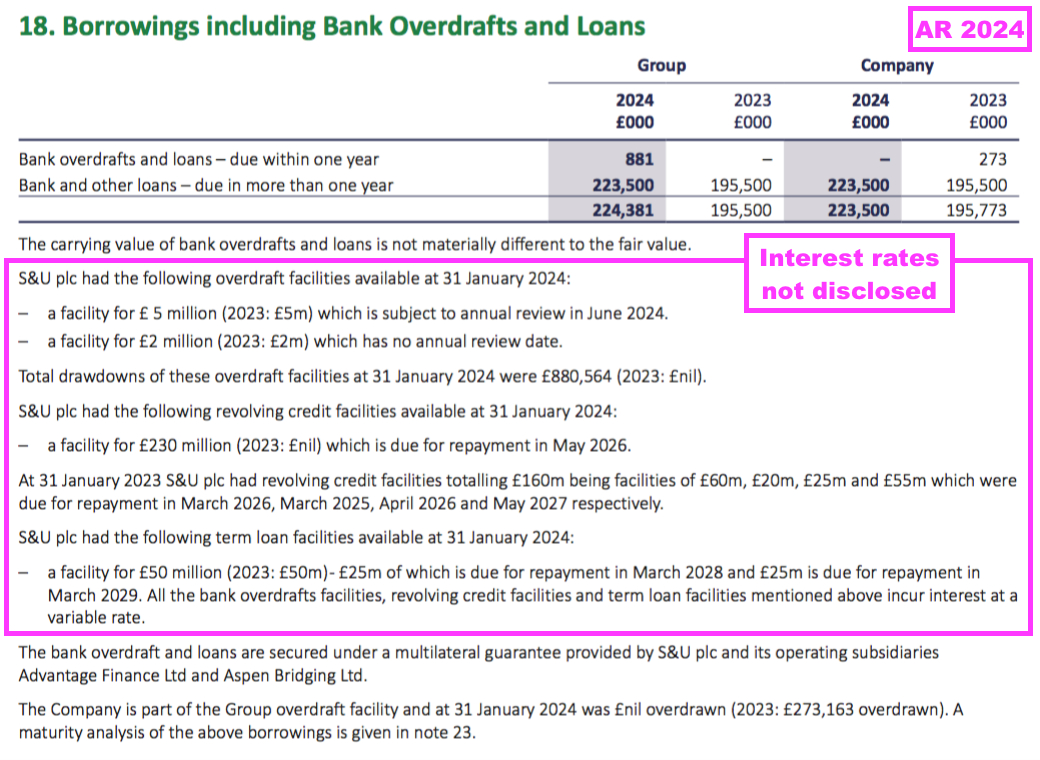
- Management’s webinar for the comparable FY disclosed:
- Borrowing costs were “just less than 3%” above SONIA, and;
- All borrowings were variable.
- SONIA is currently 4.95%, which means SUS will still be paying 8% on its debt.
- 8% on debt of £224m equates to annual bank interest of £18m — £3m more than this FY’s £15m.
- SUS could increase its borrowings by another £56m, given the loan facilities supplied by the group’s “excellent, loyal and constructive funding partners” amount to £280m (excluding a further £7m overdraft facility).
- Following this FY, August’s trading update revealed debt had increased by £16m to £240m (see June and August trading updates).
- This FY said group gearing remained “conservative, especially for a lending organisation” and management’s FY webinar reiterated several times the board was “comfortable” with the level of borrowings.
- Still, higher interest rates will diminish the returns earned on the money SUS has already lent, particularly at Advantage, where loan terms last for 54 months (see Advantage Finance: loan sizes and rates).
- Interest payable by all customers (Advantage and Aspen) is fixed throughout their agreements, meaning SUS’s variable-rate debt leads to a greater margin when rates go down but a lower margin when rates go up.
Financials: returns on assets and equity
- SUS’s debt is held within the parent company and then ‘re-lent’ to Advantage and Aspen as necessary:
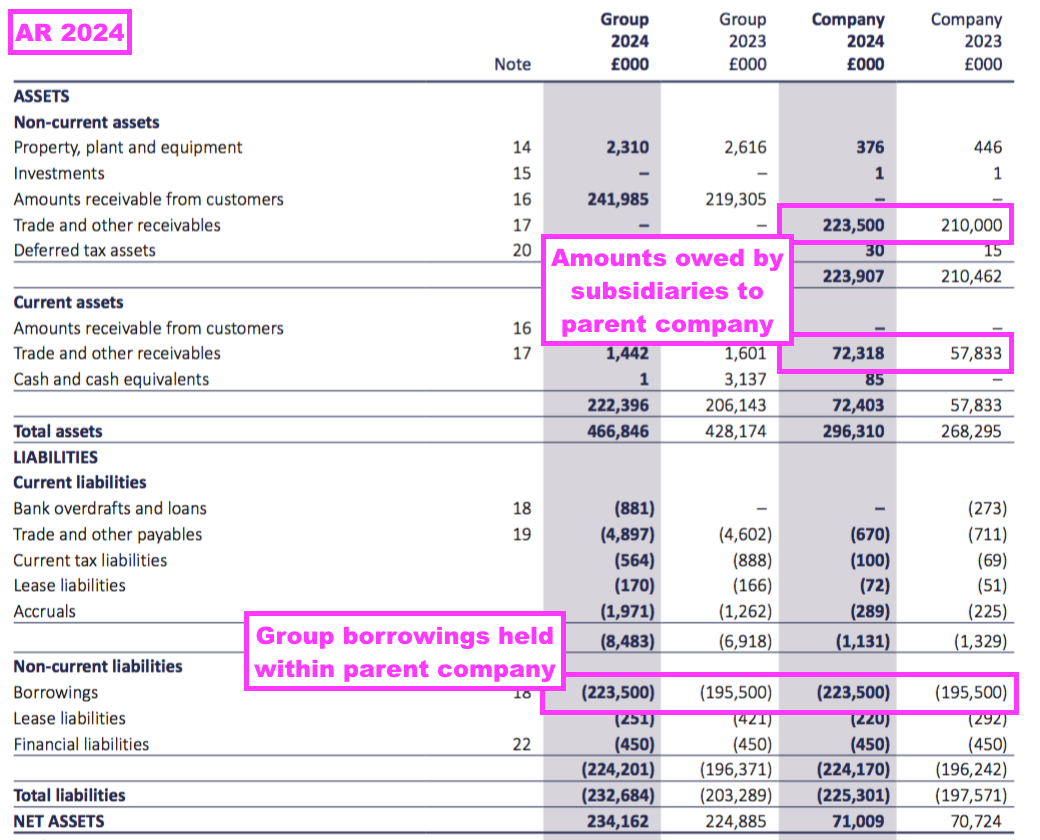
- This FY implied Advantage and Aspen owed the parent company a further £72m, which alongside the £224m bank debt effectively means the subsidiaries owe a combined £296m.
- The debts owed to the parent company — plus minor other subsidiary liabilities — enhances divisional returns on equity very significantly.
- For example, a simple pre-tax return on average assets (i.e. customer loans) for this FY gives:
- £29m/£323m = 9% for Advantage, and
- £5m/£123m = 4% for Aspen:
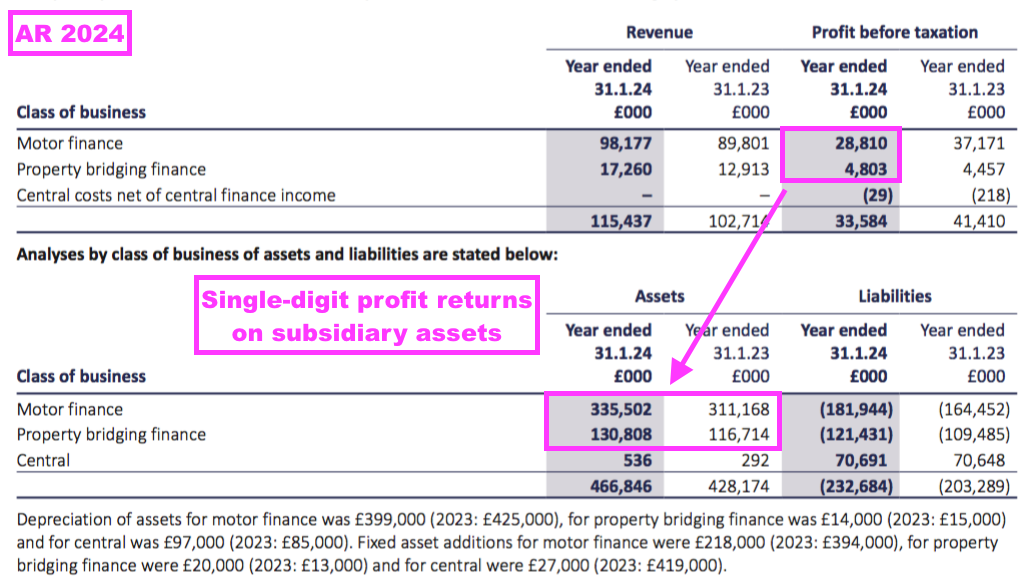
- But a simple pre-tax return on average equity (i.e. customer loans less liabilities) for this FY gives:
- £29m/£150m = 19% for Advantage, and
- £5m/£8m = 58%(!) for Aspen:
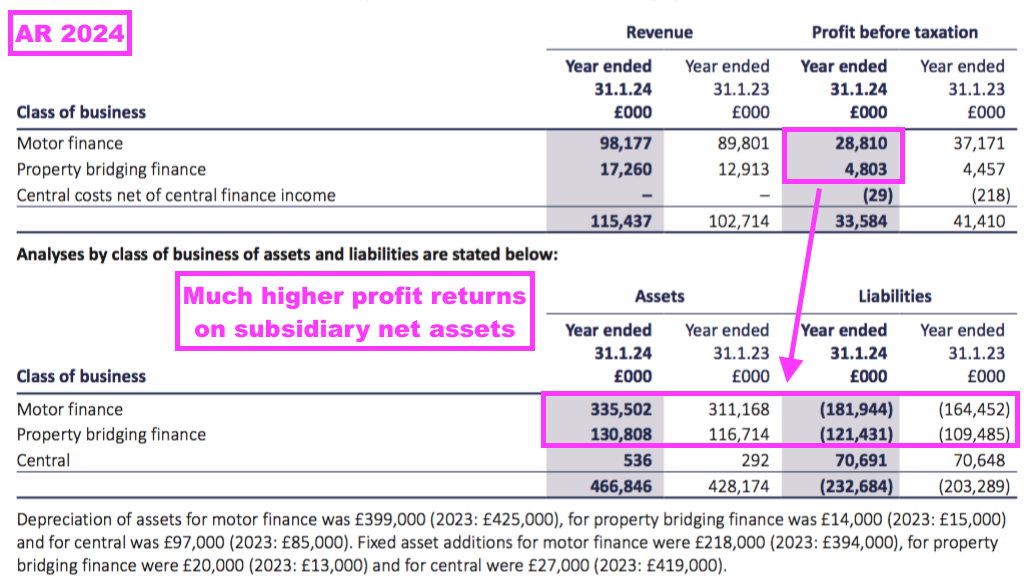
- For comparison, a simple pre-tax return on average equity for SUS gives £34m/£448m = 15%.
- With pre-tax returns on average equity surpassing that 15% for both divisions, Advantage and Aspen appear to operate successfully with gearing greater than the group accounts suggest.
- Indeed, Companies House shows Advantage’s net asset value advancing from £90m to £154m during the last five years…
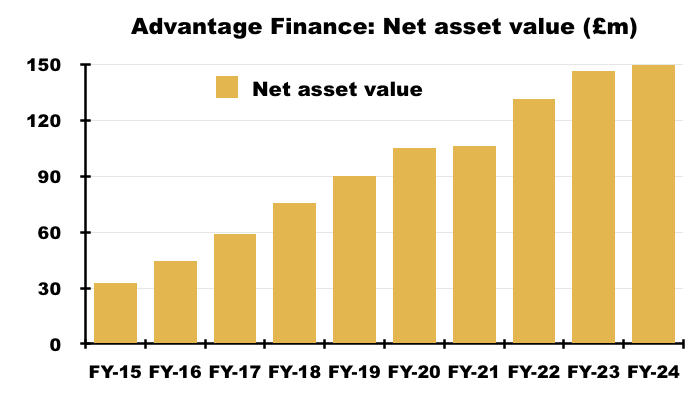
- …with cumulative dividends paid to the parent company of £65m during the same time:

- Advantage creating an additional £129m (i.e. £64m extra NAV and dividends of £65m) over five years from a starting equity base of £90m is extremely impressive, especially as the subsidiary’s expansion during those five years required extra debt funding of only £12m (see Financials: cash flow and debt).
- Companies House meanwhile shows Aspen’s net asset value increasing from £0.4m to £9.4m during the last five years, with cumulative dividends paid to the parent company of £2.7m.
- Aspen’s £12.1m of extra net asset value and dividends (£9.4m+£2.7m) was created through additional debt funding of £104m (see Financials: cash flow and debt).
- Aspen’s return on capital for that five-year period is therefore arguably £12.1m/£104m = 12%.
- But Aspen’s return on equity is off the scale — a starting £0.4m equity base generated an additional £12.1m of extra net asset value and dividends over five years without any extra equity funding.
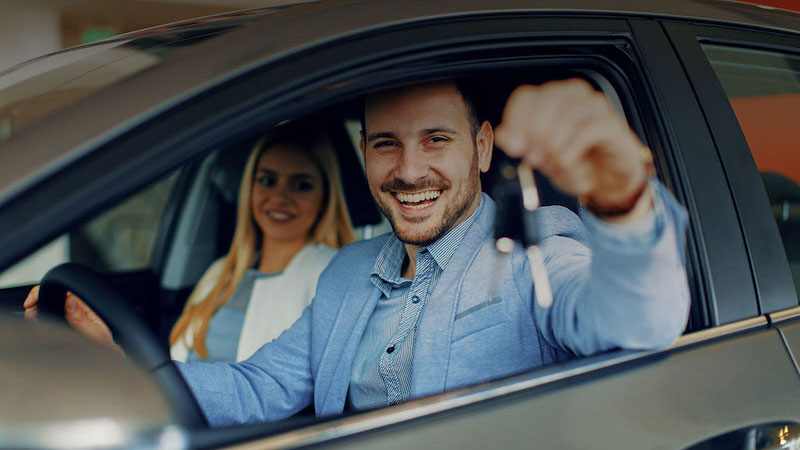
- Advantage ought to enjoy lucrative ROCEs when customers repay their loans in full and on time.
- Charging a flat 16.9% annual interest on a £8.2k loan over 54 months less cost of sales of £961 generates approximately £5.2k.
- Earning £5.2k from an £8.2k investment over 54 months equates to a 64% return or approximately 14% a year.
- Note that Advantage customers repay a mix of loan capital and interest during the terms of their loans.
- That c14% return could therefore be approximately 28% assuming the loan capital is repaid equally throughout the term.
- The same calculations for the ten years to FY 2023 are within a consistent — and appealing — 27% to 31% range.
- Of course not every Advantage loan is repaid in full and on time.
- 24% of the £437m Advantage lent originally (and still outstanding) has been impaired as a bad debt (see Advantage Finance: impairments).
- Reducing that 27% return by 24% gives a 22% return, which remains very healthy and still leaves good room for a greater proportion of non- or part-paying borrowers.
- Aspen does not seem to enjoy as lucrative ROCEs as Advantage when customers repay their loans in full and on time.
- Charging a flat 1.05% monthly interest on a £881k loan over 11 months (£102k) less cost of sales of 1.3% (£11k) generates approximately £91k.
- Earning £91k from an £881k investment over 11 months equates to only a 10% return or approximately 11% annualised.
- However, the aforementioned minimal impairments for Aspen’s loans (see Aspen Bridging) indicate the division’s borrowers are much more likely to repay their loans in full and on time.
- The minimal impairments allows Aspen to operate with much higher levels of gearing.
- Indeed, Aspen’s liabilities represent 93% of its assets versus only 54% at Advantage:
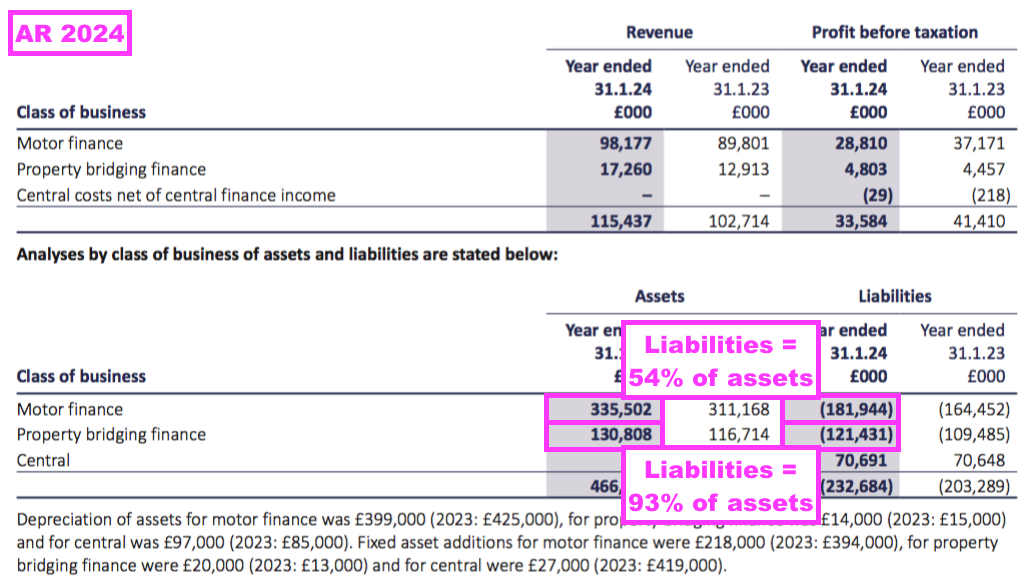
- As noted above, Aspen’s net asset value of only £8m allowed the division to earn a pre-tax return on average equity of 58% (£5m/£8m) during this FY.
- From a group perspective, between FY 2019 and this FY, SUS has created additional net asset value of £69m and paid cumulative dividends of £72m. Creating an additional £141m for shareholders from a starting equity base of £165m is respectable, and equivalent to a compound 13% total NAV/dividend return:
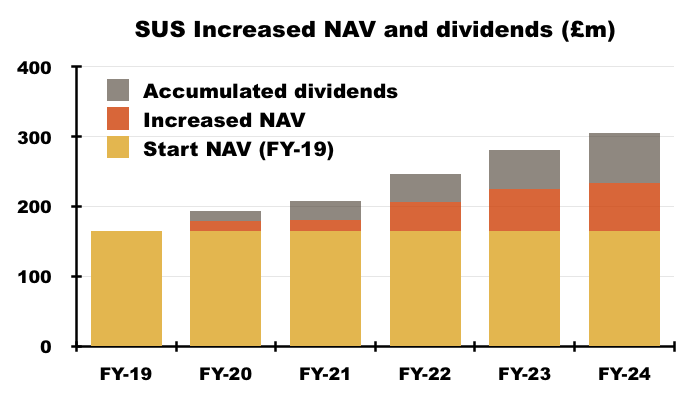
Financials: employees
- This FY’s dividend was reduced in part due to greater staff salaries (see Revenue, profit, net asset value and dividend):
“Whilst recognising its primary responsibilities to its shareholders,S&U has always sought to balance the interests of all its stakeholders. This year’s fall in profit together with our wish to protect our loyal staff from recent increases in the cost of living has made this a particularly delicate one this year.
Thus, except for senior directors, average salaries this year have matched the rate of inflation, with more for living wage earners. Higher base interest rates have cost the Group an additional £8m this year, and our incoherent Government have raised the rate of corporation tax by nearly a third.
Taking all this into account, subject to the approval of shareholders at our AGM on 6 June, the board proposes a final dividend of 50p per ordinary share (2023: 60p).”
- This FY disclosed the wider workforce enjoyed a 9% pay rise, with a 5.5% pay rise agreed for FY 2025:
“For the year ended 31 January 2024 salary increases were in the range 1.3% to 3.3% except where exceptional circumstances merited a higher increase. This was below the average increases given to the wider workforce which averaged 9.0% in a difficult inflationary cost of living environment for our employees. The Remuneration Committee has now agreed salary increases for the year ended 31 January 2025 in the range 1.7% to 3.6% except where exceptional circumstances merited a higher increase, as noted below. This is below the average increases given to the wider workforce which averaged 5.5% in light of the continued difficult inflationary cost of living environment for our employees.”
- Total employee costs increased by 7% to £13m and, despite the 9% workforce pay rise, continues to absorb 11% of revenue:
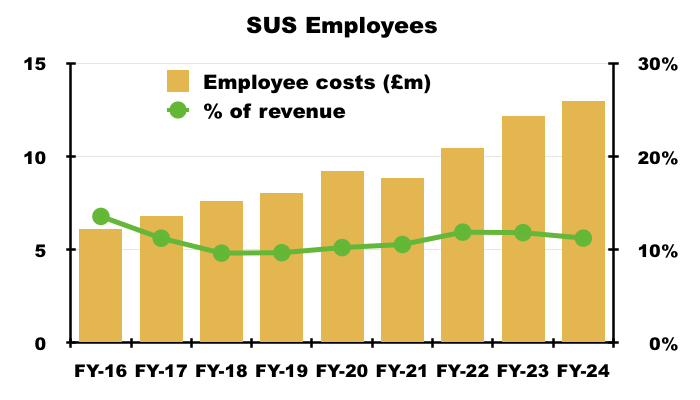
- Advantage and Aspen exhibit differing employee productivity profiles.
- Advantage’s employee productivity has not shown obvious improvements during recent FYs:

- Each Advantage employee continues to handle motor loans (before impairments) of approximately £2m and generate revenue of approximately £480k.
- Aspen employees meanwhile each handle property loans (before impairments) of approximately £5m and generate revenue of £750k:
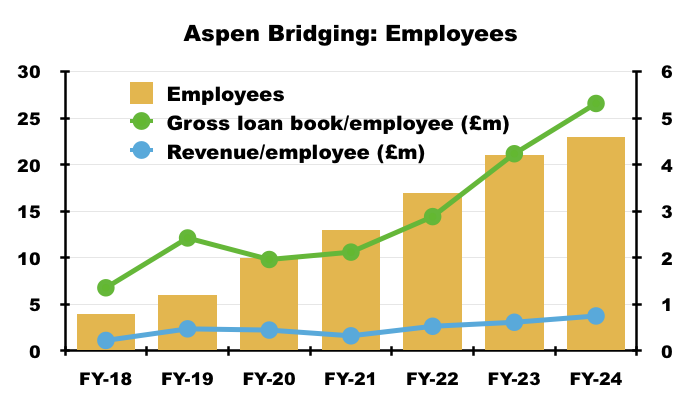
- Karl Werner, Advantage’s new boss, suggested during management’s FY webinar the efficiency of the group could be improved:
“While the the cost of operating in this modern market never seems to reduce too much there is I think an awful lot of opportunities to improve efficiencies across the firm going forward“
- This FY’s auditor’s report even noted the presence of (now automated) manual calculations for dealer commissions:
“The calculation of dealer commissions, which was previously a manual process, was automated during that year and the transition to automatic calculation simplified the audit procedures required to gain sufficient appropriate evidence on this matter so that it is no longer considered a key audit matter in the current year’s audit.”
Regulation: Borrowers in Financial Difficulty
- This FY devoted extensive text to the enhanced regulation of used-car finance (see Regulation: SUS response).
- The enhanced regulation was prompted initially by the FCA’s Tailored Support Guidance (TSG), which addressed how lenders should handle borrowers suffering payment difficulties caused by the pandemic.
- The FCA’s Borrowers in Financial Difficulty (BiFD) project then assessed how lenders had met the TSG.
- An FCA follow-up to the BiFD project then proposed various “forbearance” changes as “consumers…faced increased financial challenges due to the rising cost of living“.
- The FCA’s proposals (Annex D) were finalised during April and will come into force within the Consumer Credit sourcebook on 04 November 2024.
- From what I can tell, the general implications for Advantage (and other motor-loan lenders) are:
- More information must now be obtained from customers before lending;
- More customers may now be deemed to suffer from payment difficulties;
- Customers suffering payment difficulties may now be given more leeway to repay their loans, and;
- Vehicle repossessions may now become more difficult to undertake.
- The FCA’s policy statement widened the scope of customers who could now seek “forbearance” options.
- In particular, FCA rules concerning “particularly vulnerable” customers now apply to just “vulnerable” customers, while rules concerning customers “in arrears” now apply to customers “in or approaching arrears“.
- The new FCA text below suggests a customer “approaching arrears” may become known to Advantage sooner than before:
[FCA PS24/2] “A firm should regard a customer as approaching arrears when the customer indicates to the firm that they are at risk of not meeting one or more repayments when they fall due.”
- Forbearance measures now include accepting “no payments“…
[FCA PS24/2] “Examples of treating a customer with forbearance and due consideration would include the firm…
…accepting no payments, reduced payments or token payments”
- …and re-arranging payments over an (unspecified) “reasonable” period of time:
[FCA PS24/2] “…agreeing a repayment arrangement with the customer that allows the customer a reasonable period of time to repay the debt“.
- The new FCA text below mentions “individual circumstances of the customer“…
[FCA PS24/2] “When determining appropriate forbearance and treating the customer with due consideration, a firm must take into account the individual circumstances of the customer of which the firm is or should be aware.”
- …which must now be “sufficiently detailed“:
[FCA PS24/2] “the assessment should be informed by sufficiently detailed information;“
- Customer details include essential living expenses that may now go beyond “mortgage, rent, council tax, food and utility bills”:
[FCA PS24/2] “Priority debts and essential living expenses include, but are not limited to, payments for mortgage, rent, council tax, food and utility bills.”
- And significantly, vehicles can now only be repossessed as a “last resort“:
[FCA PS24/2] “A firm must not take steps to repossess a customer’s home, goods or vehicles other than as a last resort, having explored all other possible options.”
- Recent results from specialist lender Secure Bank Trust (STB) acknowledged the profit impact of repossessing fewer vehicles:
[STB H1 2024] “We engaged in formal discussions with the FCA about our collections processes, procedures and policies following its Borrowers in Financial Difficulty (‘BiFD’) review. As a consequence of this review, the Group temporarily paused Vehicle Finance collection activities. This has caused higher volumes of loans reaching default status and delays in repossession and recovery activities, resulting in a higher provision coverage in Vehicle Finance of 10.7% (FY 2023: 8.9%) and a cost of risk of 8.8% (HY 2023: 2.4%) for this business.”
Regulation: Consumer Duty
- Overlaying all the new BiFD rules is the FCA’s new Consumer Duty principle:
[FCA PS24/2] “Principle 12 (a firm must act to deliver good outcomes for retail customers), including PRIN 2A “
- This FY described Consumer Duty as a “paradigm shift” that replaced “a raft of secondary legislation and regulatory controls over the past 20 years”.
- The FCA’s new regime now requires lenders to deliver “good outcomes” for retail customers — although “good outcomes” are not precisely defined.
- However, the FCA has published a round-up of Consumer Duty best practices, which includes the topic of “fair value“:
“Retail customers experience harm where they don’t get value for their money. A lack of fair value is unlikely to be consistent with customers realising their financial objectives and firms cannot act in good faith if they are knowingly manufacturing or distributing poor value products or services.
Good practice:
We have seen firms:
Examine whether the total cost to consumers of their products and services – including fees, charges and other costs – provides fair value relative to their benefits. Firms have made changes to improve their value proposition by reducing costs for consumers by:
Updating pricing models for products and services. For example, reducing the rate of interest paid on certain credit products and/or for certain types of customers;
Reducing or removing charges for certain products or ongoing services where these were deemed too high relative to the benefits provided;
Putting controls in place for certain groups or customers, for whom charges over a certain amount do not offer fair value, to improve value and remove these charges“
- The main worry perhaps for SUS is the FCA not believing motor-finance products charging Advantage’s typical 33.87% APR are providing “fair value“.
- Management’s FY webinar responded to my question on this matter:
“Q: The FCA’s Consumer Duty requires firms to deliver ‘good outcomes’ for retail customers relating to, among other elements, ‘price and value’. How will S&U persuade the FCA that motor-loan APRs at 33% provide ‘fair value’ to a consumer that repays in full? Customers who repay their motor loan in full and on time may not see themselves as receiving ‘fair value’, because they effectively subsidise the customers that do not pay on time to ensure Advantage as a whole makes a suitable ROCE.
A: Ahead of the implementation of Consumer Duty in July 2023, Advantage conducted a full review and assessed that its hire purchase product did provide fair value to customers in its target market. On the cross subsidisation point please note the FCA has stated that ‘Our price and value outcome rules do not require firms to charge all customers the same amount, or to make the same level of profit from all customers’. We constantly review our pricing point in the market and continue to believe we offer a great product, competitively priced.”
- Another Consumer Duty concern is the regulatory desire for consistent product “fair value” may restrict the ability for lenders to satisfactorily recoup losses from non-paying customers. This FCA letter stated:
[FCA 2023] “Products need to continue to offer fair value when a customer falls behind with their payments, so in considering the fair value of their products firms must consider all interest, fees and charges a consumer may incur, including late payment/arrears charges. This is especially important if the target market includes consumers with poor credit rating.”
- Consumer Duty could therefore open the door for a greater number of borrowers to delay repayment and not suffer any financial penalty.
- Management’s FY webinar responded to my question on this matter:
Q: A ‘Dear CEO’ letter last year from the FCA to the motor-finance industry said: “Products need to continue to offer fair value when a customer falls behind with their payments, so in considering the fair value of their products firms must consider all interest, fees and charges a consumer may incur, including late payment/arrears charges. This is especially important if the target market includes consumers with poor credit ratings.”. This letter implies Advantage customers can now delay repayments and not suffer any great financial penalty, which would lead to lower Advantage’s ROCE. Does the board therefore agree the new forbearance rules have fundamentally weakened the long-term economics of Advantage and the wider sector?
A: Our income from collection charges and additional interest on arrears has historically not been significant (we actually do not charge any additional interest on arrears except if there are court recovery proceedings later). The more important point you indicate therefore is that a potential collection charge does help encourage customers to not delay repayment unnecessarily. We don’t believe the FCA plans to do away with reasonable collection charges in the motor finance sector as this would affect other financial sectors and products too. We also do not believe that new forbearance rules have fundamentally changed the economics of our sector, mainly as the current evolution of these rules is likely in time to provide collections improvement through a more transparent and certain platform for our customer collections activities. Moreover, we anticipate that our own continuous improvement of credit risk identification and pricing alongside these collections improvements may give us some competitive advantage.”
- The one certainty from Consumer Duty (and BiFD) is the greater regulatory cost. This FY revealed an extra £1.5m compliance expense:
“Administrative expenses [at Advantage] increased by 25% reflecting continued staff cost inflation and an extra £1.5m spent on regulatory costs this year”
- This FY repeated SUS’s claim that Consumer Duty would, with the help of a ‘skilled person‘, benefit the group (eventually):
“Of course, Advantage have responsibly embraced the new consumer duty and will further work with the regulator to make it effective in practice. First, because it is right to do so and second, since it will give well organised companies like Advantage a commercial advantage over those who are not. Advantage is currently working with the regulator and a company-appointed ‘skilled person’ to do so.”
- One regulatory issue thankfully not impacting SUS directly concerns the FCA’s investigation into motor-finance discretionary commission arrangements.
Regulation: SUS response
- This FY included numerous remarks about BiFD and Consumer Duty.
- SUS confirmed its support for the FCA’s wider objectives…
“S&U endorses the FCA’s objectives aimed at enhancing the consumer experience, safeguarding customers from the infrequent but possible negligence within the finance sector and assisting individuals in navigating challenges that may arise during the tenure of their loan. We have consistently maintained that lending is not a win-lose scenario, and believe that transparent, straightforward, and mutually agreed-upon regulations serve the best interests of both the customer and the lender.”
- …but also noted “unintended consequences” — such as a withdrawal of industry capital — arising from the FCA’s enhanced regulatory regime:
“In recent years, a notable trend has emerged contrary to expectations. The workforce of the FCA has expanded to 4,289 employees, an increase of 1,100 in the last year, paralleled by a substantial contraction in credit availability. A February report by Clearscore, a data provider and credit scorer, in collaboration with Ernst and Young, highlights a marked decrease in the availability of debt products for non-standard customers over the last twelve years.
…
Unintended consequences may include a dampening effect on [both] innovation and the introduction of new products. Furthermore, there has been a notable decrease in industry capital, with Ernst & Young estimating a reduction of £2 billion in recent years, as funders grow cautious due to concerns about repayment reliability.”
- SUS claimed an industry-wide withdrawal of capital might lead to some motor-finance borrowers unable to improve their credit scores…
“Imposing restrictions on customers’ ability to address their arrears, in pursuit of comprehensive and sometimes intrusive affordability assessments, may inadvertently lead to a preventable worsening of their credit scores.“
- …or even obtain car loans legitimately:
“For the markets serving these [non-prime] consumers to remain stable and competitive, ensuring access is paramount. Without this, numerous vulnerable consumers might find themselves resorting to unregulated, and potentially illicit, lending options—a scenario diametrically opposed to the expectations of a civilised society.“
- Undefined terms such as “affordability” and “vulnerability” within the FCA’s regulations appeared to be particularly frustrating for SUS:
“Central to ensuring consistent and equitable outcomes for customers is the precise definition of terms such as ‘affordability’ and ‘vulnerability’, which are inherently subjective and fluctuate over time, particularly in an inflationary environment where the lines between ‘essential’ and ‘discretionary’ spending may become indistinct.”
- SUS reassuringly confirmed Advantage was one of many non-prime lenders being assessed by the FCA:
“In response to ongoing concerns regarding the cost of living and its declared objective to “deliver quantifiable consumer benefits,” the FCA has launched comprehensive inquiries across the industry, affecting approximately two-thirds of non-prime motor finance companies.”
- SUS pre-empted the FCA’s assessment by modifying certain collection and recovery actions…
“In anticipation of the findings, Advantage has consented to specific limitations on its repayment processes. These modifications have temporarily influenced monthly repayments and recovery efforts. However, following constructive dialogues with the regulatory body, these measures are being thoughtfully adjusted to ensure flexibility and effectiveness.”
- …which caused the aforementioned increases to overdue accounts (see Advantage Finance: up-to-date and overdue accounts) and impairments (see Advantage Finance: impairments), and led to the 41% H2 profit slump.
- SUS’s modifying of certain collection and recovery actions has continued into FY 2025 (see June and August trading updates).
- SUS believed the regulatory changes would lead only to “temporary disruption“…
“As the motor finance industry transitions to new modes of regulation and evolving assurance of fair customer outcomes, it is to be expected that the mutual learning and understanding between firms and regulator will cause some temporary disruption.“
- …and the group would prosper thereafter:
“In future however, Advantage expects that its long-term experience and humane approach to every customer, irrespective of their background, as evidenced by its industry-leading customer satisfaction and Ombudsman “uphold” rates, will be vindicated and rightly bear fruit.“
- Trading updates issued during June and August suggested Advantage’s collection processes may become excused from FCA scrutiny during H2 2025 (see June and August trading updates)
- That said, this FY admitted SUS may be on the hook to pay compensation to borrowers “adversely affected” by Advantage’s collection practices:
“Our motor finance subsidiary Advantage was included in the FCA’s multi-firm Cost of Living Forbearance Outcomes review in 2023 and as a result the FCA concluded that enhancements may be required to Advantage’s approach to arrears management and the application of forbearance. Advantage and the FCA have been in correspondence throughout 2023/24 to discuss and agree the necessary steps and Advantage will carry out an assessment of whether any customers were adversely affected by its practices. Where this is found to be the case Advantage will seek to redress any detriment.
The financial effect of any customer redress cannot be reliably assessed at this early stage of the review. This ongoing assessment is expected to be in advanced stages in Summer 2024, with any redress being made after that.”
June and August trading updates
- Trading updates during June and August reported an extension of Advantage’s regulatory upheaval.
- June’s update said Advantage’s Q1 2025 repayments had declined by 4% and collections-of-due had dropped to 88%:
[RNS June 2024] “At Advantage, our cautious approach to repayments in the light of continuing discussions with the FCA and Skilled Person on interpreting and adapting to the new Consumer Duty regime and the sector wide review of Borrowers in Financial Difficulty, have had a significant impact on repayments and profitability.
…
Total repayments including settlements in the first quarter were 4% less than last year.
…
This cautious approach and temporary restrictions on repayments have seen live monthly collections reduce from 92.1% of due in the year ended 31st January 2024 to 87.7% of due in the first quarter this financial year with repossession receipts similarly affected.”
- Additional motor-loan impairments left SUS’s Q1 2025 profit down 34%:
[RNS June 2024] “Group profit before tax for the first quarter fell to £6.9m (2023: £10.5m)… Increased impairment provisioning arising from the lower repayments at Advantage accounted for £3.6m of this reduction.”
- June’s update anticipated “regulatory clarity” during H2 2025…
[RNS June 2024] “We anticipate that these discussions [with the FCA and Skilled Person] will be concluded during the second half of the year, when we will welcome the new regulatory clarity which will provide a strong platform for the continuing growth of the business.”
- …although August’s update then referred to “constructive but vigorous negotiations” with the FCA:
[RNS August 2024] “This [consolidation and retrenchment] has resulted from a period of restrictions and caution arising from a Financial Conduct Authority (“FCA”) section 166 notice and the constructive but vigorous negotiations taking place to remove the [collection capability] restrictions, which are now nearing their conclusion.“
- “Vigorous” negotiations suggest Advantage may have to modify certain collection and recovery actions for a while longer.
- Indeed, August’s update calling for political intervention does not feel promising:
[RNS August 2024] “The welcome (at least for now) election of a Labour government with a strong majority and a stated commitment to restoring Britain’s feeble rate of growth, will, we hope, gradually lead to a more pragmatic and realistic approach to regulation…
If these credit requirements [of our target market], which are an essential component in achieving economic growth, are to be met, the Labour ministers must change the restrictive and constantly changing regulatory regime in this country, and the paternalistic mindset behind it.”
- August’s update revealed repayments of due had dropped to 87% and up-to-date loans had dropped to 69%:
[RNS August 2024] “Although the value of monthly collections is marginally up on last year, the above restrictions on managing customer arrears and on repossessions have seen a year to date level of 87% repayments to due, from 94% last year. Up‐to‐date live receivables have fallen to 69% of the total, from 79% last year, although a release from current restrictions should see a bounce back in the second half of this year“
- At least SUS still expects a “bounce back” during H2 2025.
- Collecting 87% of repayments due is akin to Christmas occurring every month:
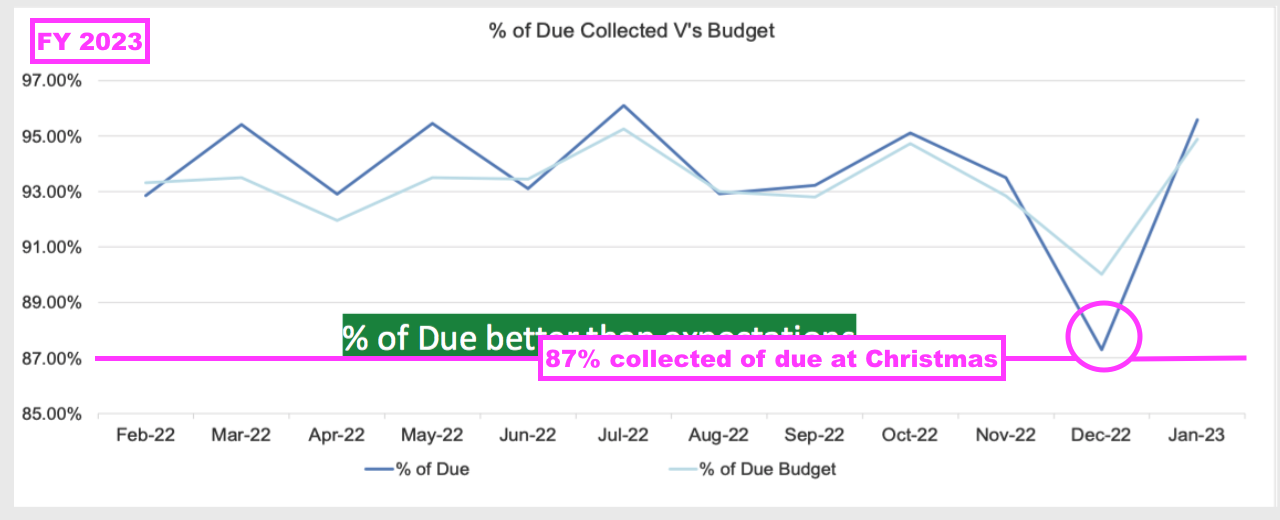

- Up-to-date loans of 69% compares to 74% for this FY, 61-73% during the pandemic and c80% pre-pandemic:
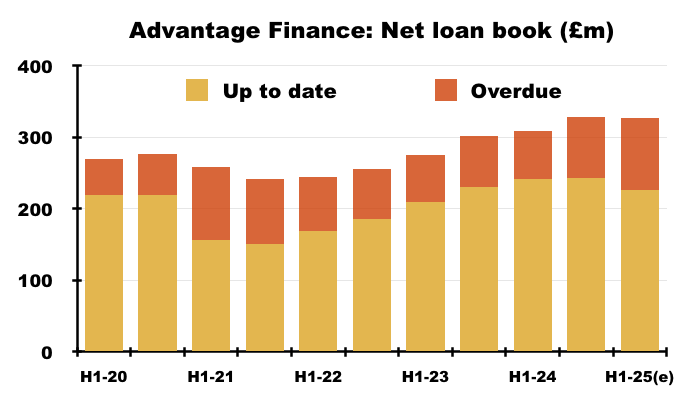
- August’s update said Advantage’s net loan book was £327m, down only £5m on the £332m reported for this FY.
- Aspen’s net loan book meanwhile had improved £19m to a record £149m since this FY. The division’s collections are up 20% on budget, too.
- August’s update confirmed year-end borrowings at £240m:
[RNS August 2024] “Group borrowings stand at around £240m (2023: £183.7m) against £224m at year end, well within current committed facilities available of £280m.
- Borrowings of £240m would incur annual interest of £19m if SUS is indeed paying interest at the aforementioned 8%.
Valuation
- The £18 shares suggest the profitability of used-car finance — and perhaps property-bridging finance as well — has been permanently diluted.
- This FY showed net assets at £234m or £19.27 per share, although August’s update implied net assets might be £236m or £19.42 per share.
- The stock market therefore values SUS at c0.93x NAV.
- The shares have traded below NAV only occasionally during the last 30 years:
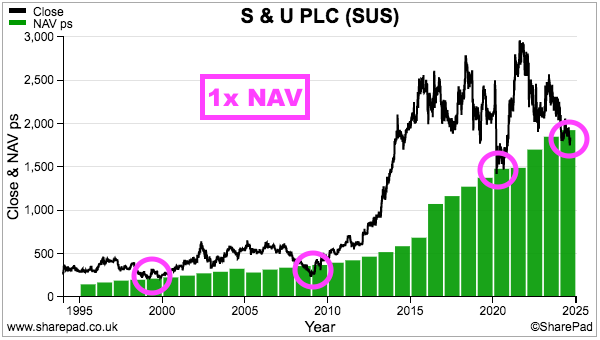
- Buying at NAV should (in theory) deliver returns equivalent to lending direct to SUS’s customers — with NAV effectively protected by the right (regulations permitting!) to repossess the secured vehicles/properties if the loans default.
- An 0.93x NAV rating therefore implies the market is very worried that regulatory changes — and possibly economic trouble — will lead to reduced collections, greater impairments and limited lending progress.
- After all, if BiFD and Consumer Duty now restrict the ability for motor-loan lenders to repossess their cars, then maybe the sector will soon be awash with later payers.
- Assuming (regulation-free) Aspen is valued by the stock market at book value, Advantage must therefore be valued at less than 0.93x its book value.
- The shares fell to £14.75 during the August 2020 pandemic lockdowns, at which point the last declared NAV was £14.81 per share.
- SUS then navigated through FCA-authorised payment holidays and general Covid disruption and, with hindsight, over-estimated pandemic-related write-offs by £15m.
- I am hopeful SUS is once again taking a prudent view of expected impairments given August’s update, but Advantage’s collections of due declining to 87% and up-to-date loans reducing to 69% are not encouraging.
- For extra perspective on past valuations, the shares dropped to 250p at the end of 2008 when NAV at the time was £43m or 366p per share.
- Mind you, SUS was predominantly a home-credit business during 2008 and may have attracted much greater worries to justify a 0.7x NAV valuation during the banking crash.
- Bear in mind the banking crash did reduce lending competition, and various measures of Advantage’s profitability improved until rivals re-emerged from 2015 onwards:
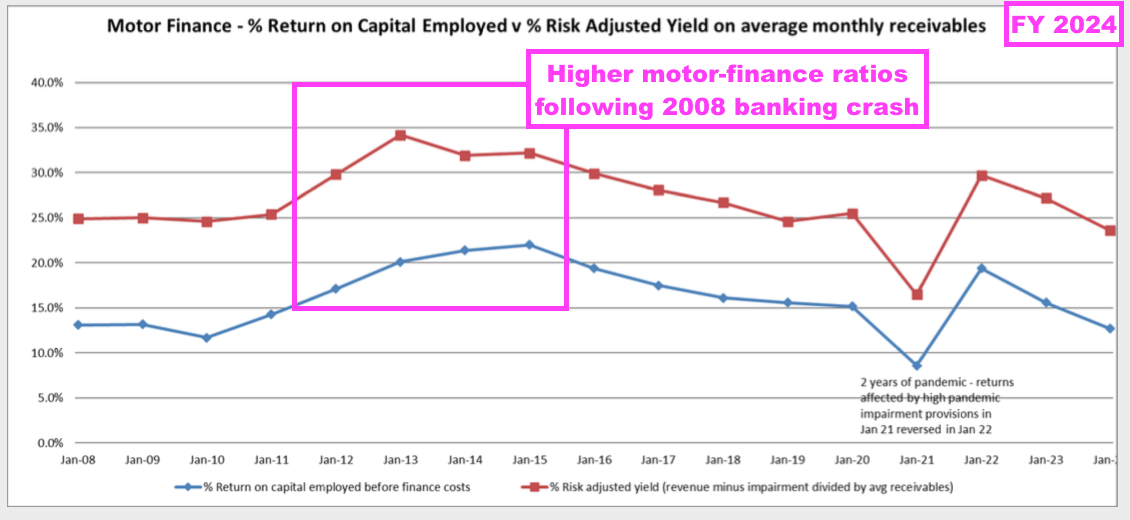
- Perhaps BiFD and Consumer Duty will combine to inhibit motor-finance competition and eventually bolster Advantage’s profitability and performance.
- In the meantime, the forthcoming H1 2025 results will reveal whether reduced collections, greater impairments and higher debt costs will continue to hinder earnings, NAV and the dividend.
- Assuming no further payout reductions, this FY’s 120p per share dividend supports a handy 6.7% yield at £18.
- This share has typically offered a useful income.
- My initial purchase during Q1 2017 was in retrospect not a great bargain at £21 with a trailing 4.1% yield, but my following top-ups did capture a greater income:
- Right now, dividends are the primary source of returns given the £18 shares are back to a level first achieved during 2014:
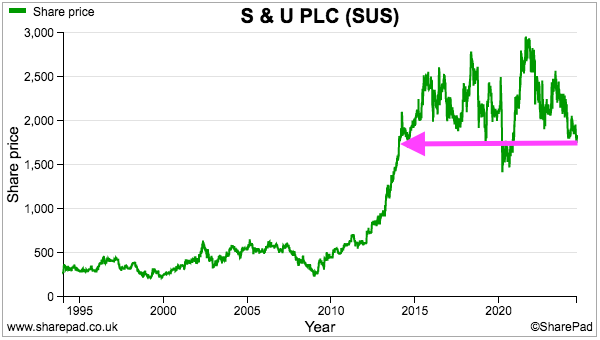
- To conclude, the aforementioned Coombs family managers have successfully navigated many previous downturns (not least the pandemic), and this FY reminded shareholders of the long-term benefit of employing such leadership:
“Our over-arching factor in the success of our business over 80 years and through three family generations of management is our business philosophy. The identity of interest between management and shareholders has fused our ambition for growth with a conservative approach to both credit quality and funding.”
- I trust the “the identity of interest between management and shareholders” will (once again) prove its worth when the regulatory dust eventually settles.
Maynard Paton

S & U (SUS)
Trading update published 19 September 2024
Oh dear — a profit warning for H1 2025. But not a huge surprise given the adverse motor-finance commentary within the June and August updates noted in the blog post above. This update was issued during market hours, which is bad form. Here is the full text:
——————————————————————————————————————
S&U PLC, the specialist motor and property finance lender, today issues an update for its expectations for the financial year ending 31 January 2025.
Advantage Finance
As previously referenced in the Group’s announcement on 12 August the cautious approach and business retrenchment adopted by Advantage Finance, the Group’s motor finance division, since the imposition of the Financial Conduct Authority’s (“FCA”) Section 166 notice have continued to impact the performance of the division, primarily resulting from restrictions on its collections capabilities.
Whilst Advantage continues to actively pursue a conclusion of negotiations with the FCA for a removal of the restrictions soon, their cumulative impact on Advantage Finance’s profitability has caused Advantage’s first half profitability to fall below expectations. As a result, Group profits in H1 are expected to be c.£12.8m and this is likely to cause the Group’s financial year profitability to 31 January 2025 to fall below market expectations.
However, the Group still anticipates improvements in Advantage Finance’s performance in the second half brought about by a plan to be implemented upon the anticipated removal of the FCA’s restrictions and appropriate modifications as a result. The timing of these nevertheless remains uncertain.
Aspen Bridging
Aspen Bridging, S&U’s property lending division, continues to deliver strong and profitable growth driven by robust business momentum and excellent credit quality whilst the outlook for the division remains exciting owing to a healthy deal pipeline, its talented and entrepreneurial team and the backdrop of falling interest rates.
S&U will announce its half year results on 8 October 2024 at which point it anticipates providing additional detail on Group and divisional performance and an update on the outlook for the full year.
Commenting on S&U’s trading outlook, Anthony Coombs, S&U Chairman, said: ”Although operating conditions at our motor finance business remain challenging, we are confident in our plan to improve performance once it is set in motion in the second half. Aspen continues to deliver healthy results and faces a bright future.””
——————————————————————————————————————
The tone of this statement implied relations between SUS and the FCA have deteriorated.
The FY 2024 statement referred politely to the FCA’s “inquiry” that focused on affordability, forbearance and vulnerable customers.
August’s statement then referred to “a period of restrictions and caution arising from a [FCA] section 166 notice“.
But now we are told about the “imposition” of the FCA’s section 166 notice, which does read as if SUS is undertaking the s166 under duress.
August’s statement mentioning “vigorous” discussions with the FCA did suggest a conclusion to the s166 might not be imminent, and sure enough this statement confirms the regulatory discussions continue. Modifications to motor-loan collections — including fewer repossessions — therefore stay in place.
SUS says H2 2025 should see an improved motor-loan performance, but everything depends on the FCA discussions… and I would not be surprised if the “anticipated removal of the FCA’s restrictions” were actually pushed into H1 2026.
An H1 2025 profit (I assume pre-tax) of £12.8m compares to £21.4m for H1 2024 but is similar to the £12.2m for H2 2024.
However, June’s statement said Q1 2025 pre-tax profit was £6.9m, so Q2 pre-tax profit was therefore £5.9m. June’s statement indicated Q1 2025 profit was hampered by extra motor-loan impairments of £3.6m. So perhaps extra motor-loan impairments for Q2 2025 were closer to £5m?
What is slightly unnerving is August’s statement had already said motor-loan net receivables were “around £327m“.
So SUS knew the value of the H1 2025 motor-loan book in August, but only now knows the H1 profit outcome — which is confusing, as the impairments within the profit calculation also influence the loan-book value.
I therefore wonder if the greater-than-expected impairments for H1 2025 may lead to the motor-loan book value within the upcoming H1 2025 results being different to the £327m stated within August’s statement. Would not look good for SUS if that was the case. The H1 2025 results will confirm whether NAV is still approximately £19 per share.
At least Aspen continues to do well.
Maynard
Hi Maynard,
I still hold S&U and, frustratingly, it seems the FCA is still ramping up its post-GFC crusade to stop anything bad happening to any consumer for any reason ever.
For lenders, this means having to bend over backwards to support borrowers who are struggling to repay loans, by reducing repayments and stretching the repayment period out to infinity. In reality, a default and repossession often makes more sense for all parties.
I also hold Close Brothers and like other motor finance businesses, it’s currently facing a huge compensation bill for so-called “hidden” commissions that were standard across the industry for more than a decade!
In both cases, I think these issues are the fault of the regulator rather than the fault of the affected companies, as was the case when the UK’s retail energy market collapsed a few years ago.
Hopefully our new government will change the FCA’s culture to focus on growth rather than an obsession with over-protecting consumers, but in the meantime, financial stocks are a painful place to be.
John
Hi John
Yes, I agree with the sentiment here. SUS has mentioned the ‘unintended consequences’ of the greater regulation, which include a withdrawal of capital from the sector and consumers seeking loans from less legitimate sources. Ultimately the sector is not a charity and, if the FCA demands the likes of SUS have to continue with their modified collection processes and repossessions become almost impossible to implement, then the APRs will have to increase and/or loan availability will shrink to compensate for the lower returns from the loan book. I fear politicians will become involved to perhaps reassess the FCA’s regime only when too many would-be borrowers (=voters) find themselves excluded from used-car finance.
Maynard
Thank you for an excellent thorough analysis of S&U Maynard, we do not hold but it remains on our buy list. Thank you also for the analysis of Castings, we continue to hold while noting and agreeing with your conclusion. I was pleased to see two more of our shares in your screen with Castings but I fear an analysis and conclusion might well be similar on them too, they are Wynnstay and Sanderson Design should they ever cross your radar.
Hi Vic,
Glad you found the analysis useful. I did recall you owned Castings, so that also persuaded me to revisit the company. Have heard positive noises in the past about Sanderson, so may well look at it if the shares stay on my screen. Never heard anything about Wynnstay, but will also consider it if it remains on my screen.
Maynard
Maynard,
Great job. Thank you.
Can you please explain what section 166 is?
Hi Max
Sorry, should have linked to the FCA’s S166 page in the text:
https://www.fca.org.uk/about/how-we-regulate/supervision/skilled-persons-reviews
Maynard
S & U (SUS)
Publication of 2024 annual report
Here are the points of interest beyond those noted in the blog post above:
——————————————————————————————————————
1) INTRODUCTION
A minor change to SUS’s “Values” for 2024, which seems to reflect the FCA’s new Consumer Duty regime and its focus on “customer outcomes“:
The 2023 text…
”* Making the customer the heart of our business.
* Respect for every customer and always treating customers fairly.
* Conservative approach to underwriting and collections to enable sustainable growth.”
…has become:
“* Making the customer the heart of our business.
* Respect for every customer and always treating customers fairly.
* Long term success and sustainable growth depend upon responsible lending and great customer outcomes.”
SUS’s mission statement continues to rely on TRUST — teamwork, respect, understanding, service and truth = “Trust is the golden seam which runs through everything we do“. This mission statement was introduced for 2022 and partly seems another nod to the regulator.
2) GROUP AT A GLANCE
This Advantage text was repeated for 2024, and does indeed suggest SUS can “punch above [its] weight” within the FLA trade association:
“Advantage Finance has grown into one of the most progressive and innovative motor finance companies in the country. As active members of the Finance and Leasing Association (FLA), and with representation on the FLA Board, deputy chair of the Motor Finance Division, and chair of the Credit Risk Committee, we punch above our weight in terms of shaping our industry.”
The FLA has taken on greater relevance to shareholders given the subsequent upheaval in the sector and the trade association’s representations to the regulator, government etc.
This 2024 text from Advantage boss Karl Werner did not say anything radical:
“Advantage continues to combine its experience, culture and expertise to thrive during challenging times and deliver for its customers, partners and shareholders. Whilst the motor finance market finds itself operating within an environment of economic and regulatory change, Advantage have succeeded in building new capabilities, expanded distribution, and continued to deliver great outcomes for customers. We look forward to the next step on our long and established journey with a sense of confidence, resilience and focus upon the opportunities ahead”
On the Aspen side, the text reiterates loans can be as large as £10m and the division now employs 25 (2023: 23) people.
3) CHAIRMAN’S STATEMENT
a) Advantage Finance
A few further quotes from the chairman with perhaps the motor-finance regulatory regime in mind.
This line suggests the customers, through their repayments, are happy with their loans:
“Our repayments are one indicator of our historically good relations with our valued customers.”
Using “perceived” suggests the FCA forbearance inquiry was unnecessary:
“However, another FCA inquiry focusing on affordability, forbearance and vulnerable customers has been initiated by the FCA across the industry to ease the perceived burden of a prolonged period of cost-of-living increases. This FCA inquiry has increased Advantage’s costs and inhibited both the range of products we offer our customers, and our ability to sensibly help them maintain their loan repayments, which bolsters their future credit rating. ”
Putting”professional fees” in quotes does give the impression the associated fees were not entirely “professional“:
“Those fundamental strengths were not reflected in Advantage’s PBT of £28.8m for two reasons. The first is that provisions prudently made on an IFRS9 estimate of future cash flows have increased by £8.2m on last year. Whether these prove overcautious or otherwise will be evident as the year progresses. The second relates to additional costs incurred as a result of the FCA’s inquiries in “professional fees””
This paragraph reads as if the FCA may not be fulfilling all of its responsibilities to the detriment of the motor-finance sector:
“We have consistently maintained that lending is not a win-lose scenario, and believe that transparent, straightforward, and mutually agreed-upon regulations serve the best interests of both the customer and the lender. This perspective aligns with the FCA’s additional responsibilities to uphold the integrity of the UK’s financial system and to foster competitive practices that benefit consumers. By fulfilling these roles, the FCA, along with other regulatory bodies, can more effectively meet its broader mandate to support the international competitiveness and growth of the UK economy”
This line seems to be SUS signalling to the FCA that 75 years of lending money is more likely to lead to successful loans/happy customers than a raft of new rules:
“S&U’s extensive experience in engaging with respectable individuals, who may not have flawless credit histories, predates the establishment of the FCA by seventy-five years.”
This line may be implying the motor-finance sector may not yet be “well-regulated“:
“History has shown that a well-regulated free-market system is unparalleled in enhancing welfare and living standards.”
b) Aspen Bridging
A prediction of house prices gaining up to 5% — which seems to have been proved correct (+4.3%):
“Given the prospects for a further fall in mortgage rates and a healthy labour market feeding latent demand, our view is that house prices will rise up to 5% on average this year, and possibly more in the south east, where most bridging activity occurs.”
Ah, this text is useful. Suggests Aspen can be ‘scaled’, despite properties needing to be individually inspected before a loan can be issued:
“The team at Aspen, based in Solihull in newly expanded offices, has grown to 25 from 21 two years ago. Since Aspen’s live book debt has roughly doubled to £130.4m in that period, productivity has substantially increased.”
I also welcome the quarterly efficiency measures:
”Efficiency measures are carried out quarterly; current trends on all measures are impressive and will be maintained.”
c) Funding and treasury
SUS’s hopes for rate cuts were well placed:
“The first half of the year saw Group funding facilities increase by £70m, excluding overdrafts, to £280m from our funding partners, comfortably in excess of our anticipated requirements until 2026. In the meantime, we budget for the current Bank rate, but hope for speedy reductions and a more growth-friendly approach from the Bank of England.”
Bank rate at the time was 5.25% and is currently 4.5%.
4) STRATEGIC REVIEW
Text that commendably reiterates S&U’s primary purpose is to “maximise” shareholders returns:
“S&U’s purpose and vision is to maximise profit and returns to its shareholders in a sustainable and responsible way. This provides security for our employees, fairness for our customers, credibility for our financial and other partners and, ultimately, the ability to enhance the communities and environment in which we live, and therefore fulfil our ESG responsibilities.”
A reminder of the typical Advantage customer:
“Although decent, hardworking and well intentioned, some of these customers may have impaired credit records, which have seen them in the past unable to access rigid and inflexible “mainstream” finance products. Advantage provides transparency, simplicity, clarity and suitability to both service and product, which these customers require.”
This section includes lots of motor-finance regulatory text emphasising comments within the chairman’s statement. For example, this text reiterated the uncertain definition of “vulnerable“:
“This year, such difficulties have been focussed on forbearance, particularly due to the FCA’s understandable concern about the sustainability of customer repayments given the prolonged cost of living pressures they are experiencing. Vulnerable customers are another area of understandable concern, but one where the definition of ‘vulnerable’ can cover a multiplicity of economic, social and emotional circumstances. Some estimates have up to 16 million people classified as vulnerable in the UK today. Nevertheless, vulnerable customers have to be recorded and accorded a different repayment treatment and the company’s policies for doing so must be laid down, wherever possible, in advance.”
Some broad industry figures from the FLA:
“Finance and Leasing Association figures show that the used car consumer finance market fell by 5% in the year to 31 January 2024. The value of the market for each of the last 5 years has been over £20 billion and the outlook for 2024 is for single digit growth.”
Now for some comments on electric vehicles, which are not prominent among Advantage’s clientele nor most used-car buyers (just 2%). I believe the ban on selling new petrol/diesel cars was initially 2030, then deferred to 2035 and is now back to 2030:
“The Government set ambitious targets for a ban on the sale of new internal combustion engine cars by 2030, although these have sensibly been put back to 2025 [should be 2035?], to be replaced by electric vehicles and hybrids. Although Advantage agrees that the proportion of electric vehicles in the UK “car parc” may reach 30% by 2030, electric vehicle sales are largely confined to socio economic groups outside those we serve. Thus, Advantage provided finance for 80 such cars last year, five times that in 2022 but a very small proportion of the 21,565 total. Although the proportion of EVs in the new car market is predicted to grow to 26% by 2025 from about 12% in 2023, petrol will still constitute at least 46% then. Even that level of EV growth will depend on supply constraints, cost and confidence in recharging points. Currently about 98% of the UK Used car finance market involves petrol or diesel vehicles.”
I like how Advantage uses its customer data “forensically” to help determine suitable lending decisions:
“Advantage’s second strength is its experienced, sensitive and sophisticated under-writing. Backed by ever more customer historical information; Advantage uses this forensically to analyse the likely circumstances of actual and potential customers.This year it has adopted greater use of ever more granular household information to improve its already sophisticated customer affordability process. The improvement in affordability monitoring during the life of the agreement has been helped by greater use of open banking and of income and expenditure surveys, although the completion of these detailed surveys and what expenditure is classified as essential can be difficult and is not helped by understandable customer reluctance to reveal every nook and cranny of their budgets.”
That said, such “affordability monitoring” may be hampered by customers not revealing every penny of expenditure.
Turning to Aspen, and an insightful stat concerning mortgage payments as a proportion of take-home pay:
“Although the pessimistic forecasts for UK average house price decline of 5% were wrong, prices did end the year 1.8% lower than the year before. In addition, transactions were still 10% down on pre-pandemic levels. Although both trends showed signs of abating at the end of the year, the proportion of take-home pay required to sustain an average mortgage remained at an historically high 38%.”
5) BUSINESS REVIEW
Mostly a repeat of earlier Advantage and Aspen commentary.
This Aspen text reveals the division’s enhanced reputation with brokers, and also reiterates every property being visited prior to the loan agreement:
“The Aspen team continues to expand its capabilities and Aspen’s reputation amongst the property bridging broking community continues to burnish. It has further tightened its valuation and underwriting processes and still insists every property upon which Aspen lends for security is personally visited by a member of the team. As a result of these strengths, further steady and sustainable growth is anticipated in the coming year.”
6) FUNDING AND BALANCE SHEET REVIEW
SUS once again compliments its lenders (now referred to as “funding” rather than “banking” partners):
“S&U has a strong balance sheet which has facilitated the group total assets growing during the year from £428.2m to a record £466.8m to take advantage of good lending opportunities. As a result, gearing increased from 85.5% to 95.8% which is still low for a financial services group. S&U net group borrowings are £224m within S&U’s medium-term facilities which were increased from £210m to £280m during the year with its excellent, loyal and constructive funding partners.”
7) PRINCIPAL RISKS AND UNCERTAINTIES
SUS understandably once again ducks out of making an economic forecast, although the UK economy is this year described as “feeble“:
“Whilst Corporate Governance guidelines, and the loan loss provisioning insisted upon by International Financial Reporting Standards require macro-economic forecasts, a feeble British economy now technically in recession, current inflationary trends, a continuing war in Europe and now an impending general election with a probable change of government make this a virtually impossible task. Against such an uncertain background, S&U has maintained its historically cautious attitude in its three-year forecasts.”
a) Consumer and Economic risks
No significant changes here versus 2023, although I think the text should be “feeble” and not “febrile”
“A febrile economic climate, wars in Ukraine and possibly a widening one in the Middle East and forthcoming elections in both the UK and USA have recently continued to adversely impact the economy and cost of living inflation including energy and fuel costs may lead to more motor finance repayment delinquency.”
b) Funding and Liquidity Risk
No text changes for 2024, although the subsequent reductions to the BoE base rate ought to have been a positive for SUS’s budget:
“The Group’s activities expose it to the financial risks of changes in interest rates and where appropriate the Group uses interest rate derivative contracts to hedge these exposures in bank borrowings. The Group has no such interest rate derivative contracts currently. However, current interest rate levels have prudently been expected to continue throughout this year in our budgeting assumptions.”
c) Legal, Regulatory and Conduct Risk
Lots of revised text for 2024.
Perhaps no surprise to read Advantage now employs two senior “Risk Officers“. Long-time Advantage director Keith Charlton has become Chief Risk Officer at Advantage, with his predecessor Alan Tuplin, another long-time Advantage director, now deemed Chief Credit Risk Officer:
“Keith Charlton is Chief Risk Officer of Advantage and plays a key role in managing and mitigating legal, regulatory and conduct risk within Advantage. Keith has over 30 years of motor finance experience and his colleague Alan Tuplin who is the Chief Credit Risk Officer has over 20 years of experience in non-prime motor finance and both have had significant involvement with the work of our trade body the finance and leasing association.”
Extra confirmation that Advantage has not undertaken ‘discretionary commission arrangements’ that are subject to an FCA investigation:
“This year has also seen an upsurge in regulatory activity by the FCA involving inquiries into Advantage as well as, we understand, into the majority of firms in the specialist motor lending industry. One such current inquiry is into the linking of interest rates charged to customers to the level of commission paid by lender to broker introducers. However, Advantage has never engaged in this practice which would cut across its long-standing model of matching rate to risk.”
Another use of “perceived” to suggest perhaps the FCA forbearance inquiry was unnecessary:
“Another FCA inquiry focusing on affordability, forbearance and vulnerable customers has been initiated by the FCA across the industry to ease the perceived burden of a prolonged period of cost of living increases. Undoubtedly this FCA inquiry has increased Advantage’s costs and inhibited both the range of products we offer our customers, and our ability to sensibly help them maintain their loan repayments, thus bolstering their future credit rating.”
One statistic that has unfortunately — but perhaps not surprisingly — increased is formal complaints to the Ombudsman:
“This year has also seen an increase in the number of complaints to Advantage reaching the Financial Ombudsman Service at 732 versus 146 last year, with most of the increase relating to the activities of claims firms and claims lawyers targeting Advantage with meritless commission and affordability themed complaints which have caused both a strain on the business as well as an unnecessary additional cost of £750 for each case. The proportion of these complaints which are upheld continues to be very low and one of the best in the industry with an uphold rate of only 16%, they still take valuable resources to deal with and we welcome moves to bring in a fee for claims firms which should make them at least think about the merits of the claims they are making.”
The Ombudsman has since changed its fee structure to reduce “meritless” complaints.
This 2023 plea is repeated for 2024:
“Given Advantage’s compliance record and the detailed operations above it is to be hoped that, in turn, the FCA will ensure an absolute clarity and identity of interpretation between itself and other regulators, particularly the Financial Ombudsman Service. Fair and effective regulation does require co-ordination and consistency.”
At least Aspen is not regulated:
“Aspen Bridging operates in the unregulated bridging sector aimed at professional borrowers.”
d) Operational Risk and Risk Management
No major text changes for 2024.
8) OUR CUSTOMERS
The usual collection of customer testimonials and ‘stock’ photos.
I have always thought SUS tried to anonymise its employees by using the same employee name in the testimonials. A few years ago, ‘Natalie’ had a good run in these case studies.
Last year, ‘Ellie’ was name checked twice. This year ‘Bayley’ and ‘Ellie’ are cited. But…this year a surname was disclosed.
“A big Thank you to Bayley Lammin for all his assistance throughout.”
And Bayley is real!
9) CORPORATE SOCIAL RESPONSIBILITY
a) Employees
New text for 2024. An impressive employee tenure at Advantage:
“Our average length of service at Advantage is 7 years, with 28% of staff having over 10 years’ service.”
Not sure if this text relates to Advantage (205 employees) or the group (239 employees), but 35 requests for flexible working reflects a notable 15% (or more) proportion of the workforce:
“In order to better support our staff’s work life balance, 35 requests for flexible working were submitted by staff and 34 of these were approved as requested. These include changes to working location, such as hybrid working, or a change to the number of hours work or their working pattern.”
New text for 2024. Seems like each employee undertook an average 6-7 courses last year:
“Over 1600 individual training courses were completed by staff over the year, these include internally developed training and a wide range of externally provided through FLA, FCA, MBL Seminars, ACAS, .Net and SAF for example.”
b) Community
More statistics about complaints and the Ombudsman:
“In year to 31 January 2024, 357 out of 424 (84%) complaints were decided by the Financial Ombudsman Service in Advantage’s favour (year to 31 January 2023: 55 out of 66 or 83%) and these levels of favourable complaint adjudications for Advantage represent the highest level versus peers in the non-prime motor finance sector. ”
Those stats differ from the earlier text:
“This year has also seen an increase in the number of complaints to Advantage reaching the Financial Ombudsman Service at 732 versus 146 last year”
I think the Ombudsman received 732 complaints, gave a verdict on 424 and presumably rejected the other 308 out of hand. From what I recall, successful Ombudsman complaints typically concern the (poor) quality of the car purchased. The upheld Ombudsman complaints are small against the 20k or so loans issued during a typical year.
SUS still donates to the TPA:
“Finally, S&U is pleased to announce its support for the Tax Payers Alliance, a non-political charitable organisation committed to ensuring efficient and effective government in the tax payers’ interest.”
c) Health and Safety and Diversity Policy
The same text as last year that dismisses modern-day ‘diversity’:
“Although we recognise that current thinking means that diversity reporting should be based around a statistical analysis of our staff’s racial origin, given our above long-standing policies, we consider that this can too often itself be divisive and potentially discriminatory. By recruiting the best people for the job, both enhance their self-esteem, irrespective of their background, racial or socio economic, and at the same time create an esprit de corps unmarked by tokenism.
It therefore goes without saying that in a Company where family values are so prized, and where staff turnover is so low, that workers are always treated fairly without any form of discrimination. Recruitment and promotion decisions, whilst reflecting the social and racial makeup of the areas in which we operate, are always based on ability and aptitude, not according to any racial or gender stereotypes.”
d) Climate Change
Mostly the same text as 2023 with the target of becoming ‘net zero’ still 2030.
I note the aforementioned Alan Tuplin has been replaced by Mike Walker for ESG purposes:
“Our biggest business Advantage Finance reports to the ESG committee through its experienced director Mike Walker.”
SUS’s emissions advanced 12% during 2024:
Revenue improved 12% during the year, too, so perhaps extra emissions are to be expected. I suppose Aspen employees visiting every property before issuing a loan — and the general growth of that division — adds to the emissions.
Revenue per tonne of C02 remained at 1.1 and below the 1.4 target
All the climate text boiled down to two generalised and unchanged risks:
SUS’s simple conclusion was unchanged:
“Climate risk is an emerging risk but it is not currently considered a significant risk for the Group.”
I note SUS’s brevity with its climate change/emission reporting, which comes to less than three pages. Fellow main-market-listed companies, CLIG and MTVW, devote several more pages to the subject… although both firms have similarly small Scope 1/2 emissions.
10) BOARD OF DIRECTORS
9 of the 10 faces from the 2023 report feature in 2024. A (very) long-time non-exec retired during the year.
No board position yet for new Advantage boss Karl Werner, who was appointed to his current position on 01 February 2024. His predecessor Graham Wheeler waited exactly a year to be appointed as a board member after becoming Advantage CEO, so Mr Werner’s board ‘promotion’ has been seemingly delayed. Not sure whether the board has doubts about Mr Werner, or whether the board has been simply preoccupied by wider industry matters.
SUS’s long-time FD has recently signalled his retirement. One of the non-execs was appointed in 2015 and now exceeds the best-practice nine-year stint. Another non-exec will reach his nine years on the board later this year.
11) DIRECTORS’ REMUNERATION REPORT
Lots of useful snippets here:
a) 2023/24 key decisions and pay outcomes
Similar text as 2023, but for 2024 includes the word “difficult” when describing decisions about pay:
“Group profit before tax reduced from an impressive £41.4m in 2022/23 to £33.6m in 2023/24. This result derives mainly from reduced repayments and increased impairment at Advantage in the second half of the year together with increased regulatory and funding costs. The Committee noted that this result was still robust in a challenging environment and would not have been possible without the hard work, leadership, focus and strength of the executive team at S&U as well as the overall resilience of the Company. We have taken this into account in the difficult decisions taken regarding salaries and bonuses, whilst at the same time maintaining good discipline in our policies on remuneration.”
The “difficult” decisions no doubt relate to rewarding directors for their efforts in light of the year’s 19% profit shortfall and annual dividend being cut from 133p to 120p per share.
The two lead Coombs executives commendably waived their £10k bonuses:
“Group Profit Before Tax (“PBT”) for the year of £33.6m was significantly below budget and decreased by 18% on the 2023 result. Therefore, the Remuneration Committee determined that for the financial year 2023/24 a bonus of £10,000 each would be awarded to Anthony Coombs and Graham Coombs which was significantly lower than their target bonus of £60,000 due to the actual group PBT of £33.6m being below their on-target performance level of £43m group PBT.
Anthony Coombs and Graham Coombs have elected to waive their entitlement to these bonuses of £10,000 each. ”
A £43m PBT bonus target compares to £41.4m PBT for 2023, so only a 4% profit improvement was required for an “on-target performance“.
No mention of the FD waiving his £10k bonus:
“The Committee also determined that for the financial year 2023/24 a bonus of £10,000 would be awarded to Chris Redford, which was significantly lower than his target bonus of £50,000 and his maximum annual bonus of £75,000, given both the normal bonus target of £42m group PBT and the stretch bonus target of £44m group PBT respectively were not reached.”
The FD enjoyed a lower bonus target than the lead Coombs executives (£42m versus £43m), and his £42m target was only 1.4% greater than the £41.4m recorded for 2023.
The FD’s £44m stretch bonus target was only £2m greater than his normal bonus target. For 2023, the gap was £3.9m (£39m versus £42.9m, or 10%).
The FD’s 5,000 shadow options did not vest.
Former Advantage boss Graham Wheeler received a £20k bonus during his final executive year:
“The Committee have considered Graham’s management of the Advantage Finance team in light of the significant challenges in consumer motor finance arising from the political and economic environment, and the Advantage PBT result of £28.8m for the year ended 31 January 2024. The Committee judged the level at which the annual bonus payment should be made. For the financial year 2023/24 a bonus of £20,000 was awarded to Graham Wheeler which was significantly lower than his target bonus of £50,000 and his maximum annual bonus of £75,000.“ Mr Wheeler’s 5,000 shadow options did not vest either.
Aspen boss Ed Ahrens received a £10k bonus:
“The Committee have considered Ed’s management of the Aspen Bridging Finance team in light of the competitive landscape and the Aspen PBT result of £4.8m for the year ended 31 January 2024. The Committee judged the level at which the annual bonus payment should be made. For the financial year 2023/24 a bonus of £10,000 was awarded to Ed Ahrens which was significantly lower than his target bonus of £30,000 and his maximum annual bonus of £40,000. ”
Mr Ahrens’ 3,000 shadow options did not vest as well.
Jack Coombs completes the modest bonus awards with a £10k payment:
“The Committee have considered Jack’s significant contribution to the continued growth of Aspen Bridging, including growth during the year ended 31 January 2024, helping Aspen Bridging achieve a profit before tax of £4.8m. The Committee judged the level at which the annual bonus payment should be made. For the financial year 2023/24 a bonus of £10,000 was awarded to Jack Coombs which was significantly lower than his target bonus of £30,000.”
b) Key remuneration decisions and related matters for the year ending 31 January 2025
Modest pay rises for most of the board for 2025:
“The Remuneration Committee has now agreed salary increases for the year ended 31 January 2025 in the range 1.7% to 3.6% except where exceptional circumstances merited a higher increase, as noted below. This is below the average increases given to the wider workforce which averaged 5.5% in light of the continued difficult inflationary cost of living environment for our employees. After a review of market comparables, and after his excellent performance as an executive director of our growing Aspen Bridging subsidiary, it was decided to award Jack Coombs a salary increase of 25% for the year ended 31 January 2025.
Jack Coombs was paid £120k during 2024, so a 25% pay rise feels justified given his lead role growing Aspen. Fellow Aspen director Ed Ahrens was paid £208k for 50 weeks during 2024.
But whether the board as a whole ought to have enjoyed pay rises during a year when shareholders had their income cut — the dividend was reduced from 133p to 120p per share — remains open to debate.
The lead Coombs executives plus the FD all have £10k lower bonus payment potential for 2025 than 2024:
“For the year ending 31 January 2025, where the targets levels of performance set are achieved, the annual bonus has been set at £50,000 for Anthony Coombs and Graham Coombs, £40,000 for Chris Redford and £30,000 for Ed Ahrens and Jack Coombs.”
As mooted in the 2023 annual report and now confirmed in this 2024 report, up to 25% of bonuses will be (disappointingly) dependent on “non-financial targets” for 2025:
“The annual bonuses will continue to be mainly assessed against stretching divisional and group Profit Before Tax (PBT) targets and Return on Capital Employed (ROCE), although up to 25% of the annual bonus will now be assessed based on the achievement of specific non-financial targets. These non-financial targets will be confirmed during the year ending 31 January 2025, but the Remuneration Committee aims to align the targets to the Company’s KPI’s in the areas of governance structures and environmental impact. The Committee believes Environmental, Social and Governance factors have become critical to good business practice and are tied to the success and long-term sustainability of organisations across all sectors and these will therefore be carefully considered when setting the non-financial targets for the annual bonus.”
Bonuses based on ESG matters and similar are always hard to judge for outsiders. A cynic might suggest that, given the problems in the wider motor-finance industry, some directors may have more success achieving the (so far undefined!) ESG targets than their financial targets.
Another 3,000 shadow options for Mr Ahrens and another 5,000 for the FD were granted for 2025.
Base non-exec fees are up 3.3% for 2025 after rising 2.7% for 2024.
c) Remuneration Policy Report
Shareholders at the 2024 AGM voted on (and approved by 97%) a new remuneration policy.
The previous policy allowed, in “exceptional circumstances” to lift the maximum combined bonus/LTIP payout from 150% to 200% of salary. This new policy simply limits the maximum combined bonus/LTIP payout to 150%.
Lots of extra remuneration-policy text for this report, with most appearing quite standard.
The policy text does confirm the 2025 salaries for the five executives:
“Anthony Coombs: £385,000, Graham Coombs: £370,000, Chris Redford: £260,000, Ed Ahrens: £215,000, Jack Coombs: £150,000”
SUS is the only company I know that (commendably) uses shadow options, which effectively operate as a cash bonus scheme based on the share price:
“Under the LTIP, the Remuneration Committee may grant nil-priced shadow share options that will deliver the equivalent share value in cash, resulting in no equity dilution for shareholders as a result of these awards.”
This is good to know:
“Targets, whilst stretching, do not encourage inappropriate business risks to be taken.”
And pension contributions for directors remain up to a very generous 15% of salary:
“Maximum contributions for a director will be up to 15% of base salary.”
This text suggests SUS is not extravagant with workforce salaries:
“Remuneration arrangements are determined throughout the Group based on the principle that reward should be sufficient to attract and retain high calibre talent, without paying more than is necessary, and should be aligned to the delivery of our business strategy.”
Note that bonuses and shadow options are available to only those employees demonstrating “exceptional” performances:
“The Committee takes into account the wider pay context and all members of staff receive an annual pay review. All members of staff whose performance has been exceptional are entitled to a discretionary bonus. .
…
Senior management whose performance has been exceptional may also be eligible for shadow share options with similar performance conditions to the shadow share options awarded to executive directors.”
This text could be relevant to Karl Werner’s appointment as the new Advantage boss:
“It is not the Company’s intention to make non-performance related incentive payments (for example, “golden hellos”). .. The Remuneration Committee may make payments or awards to recognise or ‘buy-out’ remuneration arrangements forfeited on leaving a previous employer. The Remuneration Committee will normally aim to do so broadly on a like-for-like basis taking into account a number of relevant factors regarding the forfeited arrangements which may include the form of award, any performance conditions attached to the awards and the time at which they would have vested.”
For the first time I think, SUS’s annual report now includes payment-scenario charts:
d) Annual remuneration report
Confirmation of the board’s 2024 pay:
The lead Coombs executives may not be underpaid at a £371k average salary and I do think a non-family business would not require both an executive chairman and an executive deputy chairman.
The remuneration of the lead Coombs executives is starting to appear less than ideal given the direction of the share price and dividend.
The chairman’s salary for example has advanced 11% over the last five years, while the dividend has advanced only 1.6% (up 2p to 120p) during the same time after this year’s reduction (from 133p to 120p).
The chairman’s benefits are meanwhile up 69% during the same five years to a notable £88k. Benefits are listed as “company car or allowance, private fuel, life insurance and private medical insurance“.
At least the pay increases to the lead Coombs executives have been lower than those given to the wider workforce since 2021:
Pay increases for the lead Coombs executives will be sub-2% for 2025:
(In contrast, total 2025 dividends declared to date have been reduced by 10p to 60p per share :-()
Jack Coombs on £150k (+25%) as co-lead Aspen director still appears good value for shareholders (I presume he is full time!).
Although bonuses were limited for 2024, the 15% pension contributions — which of course rise with salaries — helped make up the shortfall:
I must admit I had not realised SUS’s total return just matches that of the FTSE small-cap index during the last ten years:
Voting at the 2023 AGM did not show huge dissent on pay:
Of the c6.0 million votes cast in favour, approximately 4.9 million probably relate to the Coombs family directors and an associated venture:
From this annual report combined with subsequent RNSs, I calculate Anthony Coombs (+PCAs) owns 10.1%, Graham Coombs (+PCAs) owns 13.6%, Jack Coombs owns 13.8%, Jennifer Coombs owns 3.8%, Celia Coombs owns 0.6% and Grevayne (a Coombs vehicle) owns 3.1% = 45.0% or c5.5 million of the 12.15 million share count.
None of the non-execs own any shares, despite Graham Wheeler being an executive for four years and two others being on the board for nine years or more.
Total board pay was £2.1m, or almost 1% of the £234m net asset value or a notable 17% of the total £13.0m employee expense.
The 2025 pay report will be another interesting read given the lower dividends so far declared after this annual report.
I have felt the Coombs executives are pretty straight with outside shareholders and SUS’s longer-term track record does not lead to obvious remuneration complaints about rewards for failure.
But if the inherent economics of the motor-finance industry have deteriorated permanently following the various FCA investigations and the eventual verdict from the Supreme Court, then the pay/bonus inflation enjoyed by the lead Coombs executives etc can’t just ignore shareholders suffering a permanent dividend ‘reset’.
12) GOVERNANCE
a) Audit committee report
No changes to the text from 2023 to 2024. The “significant matters” considered by the committee remain “impairment of receivables” and “revenue recognition“.
I did not know “non-audit services” by the auditor can include a “review” of the interim results:
“Overall the fees paid to the external auditor for non-audit services were £30,000 (2023: £25,000) and this was for the half year review of interim results.”
b) Corporate Governance
No major changes to the text from 2023 to 2024.
A reminder of why SUS’s family management is not entirely compliant with corp-gov best practice:
“In S&U’s case this has always meant an identity of interest between major shareholders and the executive management of the Company. The requirement of the Code of Principles for Board’s to “promote the long-term sustainability or success of the Company, generating value for shareholders and contributing to wider society” is sustained by this and by our consistent mantra of “steady, sustainable growth.” Our mission statement is published on the inside front cover. Family investment and management has over the past 85 years been reflected in ambition for growth and for new markets buttressed by a conservative approach to risk, to treasury activities and to return on capital employed. The same culture is seen in “work force engagements” through employment stability, good communications and a streamlined, non-bureaucratic, management structure, as a staple of S&U well before the Governance Code even existed.
Under Provision 9 of the Code it is recommended that the Chairman should be independent on appointment and should not have previously served as Chief Executive of the Company and under Provision 19 of the Code it is recommended that the Chairman should not remain in post beyond nine years from the date of their first appointment to the Board. Mr. Anthony Coombs was appointed Chairman in 2008 as part of an established succession plan reflecting the Coombs family’s significant holding in S&U, the identity of interest between management and shareholders and the consequent success of the Company. As explained above this has been (and is perceived by the investing community) as a significant strength in the responsible, long-term strategic approach to S&U’s development.”
The text did include some notes on the appointment of new Advantage boss Karl Werner:
“The [Nominations] Committee together with appropriate outside advisers also played a key role in the succession planning and the successor recruitment process ahead of the retirement of Graham Wheeler as CEO of Advantage Finance on 31 January 2024.
Within this process the Nomination Committee also considered the potential suitability of Advantage Finance CEO candidates to join the S&U Board after a suitable assessment period. The recruitment process led to the successful appointment of Karl Werner to succeed Graham Wheeler as CEO of Advantage Finance on 1st February after a planned 3-month handover period. Karl was formerly Managing Director of Motor, Aldermore Bank and before that Deputy CEO of MotoNovo Finance and is already bringing his extremely impressive skills to his new role as CEO of Advantage Finance.”
So… that text confirms the board has “considered the potential suitability of Advantage Finance CEO candidates to join the S&U Board “, which so far has not yet resulted in the successful candidate, Mr Werner, joining the main board.
This text is all new for 2024 — acknowledging the all-male board and the desire for a female board member:
“In total all nine of the current S&U plc board of directors are men of which one is from a minority ethnic background. The Board therefore confirms in accordance with listing rule 9.6.8 (9) that as at 31 January 2024 it had not met the targets for listed companies of at least 40% of the individuals on the board of directors being women and at least one of the senior board positions being a woman, due principally to other candidates having more particular skills and experience for the handful of recent appointments made. Whilst we believe appointments will continue to be made on relevant ability and experience, we would like to make better progress towards these targets and welcome more women to the Board. The Board confirms that it has met the target that at least one individual on its board of directors is from a minority ethnic background.”
Diversity numbers below, showing 33 of 34 executive managers being “British white or other white“:
Only five board meetings and one remuneration meeting, versus four audit meetings, which is a welcome balance.
13) DIRECTORS’ REPORT
The maximum number of directors was 10 but is now 15?!:
“The Board may appoint a director during the year and until the dissolution of the next AGM as long as the maximum number of 15 directors is not exceeded.”
Presumably increasing the number from 10 to 15 allows Mr Werner and perhaps a female director to be appointed.
14) INDEPENDENT AUDITOR’S REPORT
a) Conclusions relating to going concern
Two audit procedures from 2023 were omitted for 2024:
“* Testing the accuracy and functionality of the model used to prepare the directors’ forecasts;
* Engaging in regular discussions with the directors regarding the status of negotiations in respect of new financing options;”
b) Key audit matters
The sole key audit matter for 2024 is “measurement of loan impairments on loans and advances to customers“.
The other matter from 2023, “revenue recognition — constant periodic rate of return assessment as per IFRS 16, has been dropped. The reason — dealer commissions are now calculated automatically!:
“The key audit matter remains consistent from prior year, except that the key audit matter in respect to revenue recognition – constant periodic rate of return assessment as per IFRS 16 is no longer considered a KAM. The calculation of dealer commissions, which was previously a manual process, was automated during that year and the transition to automatic calculation simplified the audit procedures required to gain sufficient appropriate evidence on this matter so that it is no longer considered a key audit matter in the current year’s audit.”
Various small text revisions for the remaining key audit matter, which essentially reflect SUS’s difficulties with economic “modelling“:
“In the financial year, this has been made all the more challenging by the cost-of-living crisis putting additional financial pressure on household finances and their ability to service debt, greater volatility in used vehicle prices and how management’s loan provision reflects these risks.
The unprecedented economic environment is making modelling even more challenging, including the Group’s choice of macroeconomic scenarios and weightings.”
c) Scope and materiality
A full-scope audit was undertaken on 100% of the group (parent company, Advantage Finance and Aspen Bridging).
Overall materiality was set to the standard 5% of pre-tax profit.
Performance materiality remains at 65% of overall materiality and repeated text that, while not alarming, still does not read quite well:
“We set performance materiality at £1.1m (2023: £1.3m), which represents 65% (2023: 65%) of overall materiality. In determining the performance materiality, we considered a number of factors, including the effectiveness of internal controls and the history of misstatement, and concluded that an amount toward the upper end of our normal range was appropriate.”
15) ACCOUNTING POLICIES
Just one minor text change for 2024, which relates to the macro-economic overlays used to calculate potential loan impairments. SUS now assumes used-car prices will remain stable after predicting a 13.5% drop within the 2023 report:
“The macroeconomic overlay assessments for 31 January 2024 reflect that further to considering such external macroeconomic forecast data, management have judged that there is currently a more heightened risk of an adverse economic environment for our customers. To factor in such uncertainties, management has included an overlay for certain groups of assets to reflect this macroeconomic outlook, based on estimated unemployment and inflation levels in future periods. An overlay for used vehicle prices was also included at 31 January 2023 as we assumed at that point that these prices would fall by 13.5% after a large increase in the previous 12 months. As at 31 January 2024, we have not included an overlay for used vehicle prices as we assume that used vehicle prices will now remain stable after the anticipated large decrease in the previous 12 months.”
Here are the overlays:
I think we can safely assume these overlays are ‘best guesses’ and most likely will be disrupted — favourably or unfavourably — by ‘events’.
Changes to unemployment and inflation will have the following impact on SUS’s impairments:
“An increase by 0.5% in the weighted average unemployment rate would result in an increase in loan loss provisions by £1,108,644. A decrease by 0.5% would result in a decrease in loan loss provisions by £1,108,644. An increase by 0.5% in the weighted average inflation rate would result in an increase in loan loss provisions by £503,929. A decrease by 0.5% would result in a decrease in loan loss provisions by £503,929.”
For perspective, the 2024 impairment charge was £24m and the total carrying value of loan write-downs is £107m.
I suspect the greatest impacts on impairment values for the next year or two will be from regulation and legal verdicts — matters that the accounting-standard setters do not require money lenders to estimate through a macro-economic overlay!
Confirmation of the impairment impact of used-car prices rising or falling:
“At the year ended 31 January 2024, we have assumed that used vehicle prices will remain stable after a period when used vehicle prices increased during years ended 31 January 2022 and 31 January 2023 and then decreased during year ended 31 January 2024. This assumption as at 31 January 2024 has been made after considering market trends and expectations but is uncertain. If used car prices were assumed to fall by 5% instead, then this would result in an increase in loan loss provisions of £2,967,534. If used vehicle prices were assumed to increase by 5% instead, then this would result in a decrease in loan loss provisions of £2,967,534.”
16) SEGMENTAL ANALYSIS
The segmental split of assets and liabilities indicates how the group is structured for the board to make its ‘capital allocation’ decisions:
Debt is held within the parent company, and the borrowed money is then lent internally to both divisions as required. The positive c£71m liabilities for the Central segment reflect the sums owed by the two divisions to the parent company. Both divisions transfer their profits (via an internal dividend) to the parent company and the board then allocates those profits, either to i) reinvest into the same division, ii) invest in the other division, iii) reduce debt, or iv) pay out as a dividend.
17) EMPLOYEES
Average wage and total cost per employee were £47k and £54k respectively:
Both figures are very similar to the equivalents for 2022 and 2023 and a bit higher than those for 2019, 2020 and 2021, but match those for 2017 and 2018. So employee expenses have generally been kept under control — despite the pay increases (6.1%, 3.0%, 9.0% and 5.5% for the wider workforce during 2021, 2022, 2023 and 2024 respectively). I therefore suspect some workers have left and been replaced by lower-cost employees.
As per the blog post above, the motor-finance workforce has not really shown great productivity improvements on a gross-receivables and interest-received basis. I suspect that lack of productivity improvement is due to a greater number of regulatory-compliance employees.
As per the blog post above, at least the property-finance workforce has shown useful productivity improvements. So maybe this division really is ‘scalable’, despite having to visit every property in-person before agreeing the loan.
18) AUDIT FEES
Total audit fees up a substantial 22%, but remain under control at a lowly 0.2% of revenue (£230k/£115m):
19) FINANCE COSTS
Interest on the debt is accompanied by a £141k preference dividend:
20) TAXATION
SUS’s tax adjustments must be among the smallest in my portfolio:
I tend to gloss over tax matters, and often I am never quite sure whether adjustments leading to low tax rates are sustainable.
21) PROPERTY, PLANT AND EQUIPMENT
SUS employs minimal tangible assets relative to the £463m loan book:
Company cars are in the books at £160k. I suppose the right-to-use assets may include company cars on leases.
22) TRADE AND OTHER RECEIVABLES
Minimal figures here:
23) BORROWINGS
A quick check on banking-facility renewals and repayments:
A £5m overdraft facility was subject to a review in June 2024.
Next up is the £230m revolving-credit facility due for repayment in May 2026.
Then a £25m term-loan facility due for repayment in March 2028 and another £25m term-loan facility due for repayment in March 2029.
And an extra line this year, finally confirming all the debt is variable rate:
“All the bank overdrafts facilities, revolving credit facilities and term loan facilities mentioned above incur interest at a variable rate.
But still no mention of the rates charged!
24) TRADE AND OTHER PAYABLES
Minimal figures here:
Largest payable of £4m includes broker commissions and remuneration. The latter I presume could be staff bonuses determined at the year-end but to be paid in the next financial year (actually the remuneration payable includes the shadow-option LTIP sums payable — see point 26 below).
Total cost of sales for 2024 were £22m, with broker commissions being a significant part of that expense.
I suspect the bulk of the largest £4m payable is commissions, and SUS makes such payments some time after the commission has been earned by the broker.
25) CONTINGENT LIABILITIES
Oh dear — all new text for 2024 highlighting the potential for “redress” following the FCA’s forbearance review:
“Our motor finance subsidiary Advantage was included in the FCA’s multi-firm Cost of Living Forbearance Outcomes review in 2023 and as a result the FCA concluded that enhancements may be required to Advantage’s approach to arrears management and the application of forbearance. Advantage and the FCA have been in correspondence throughout 2023/24 to discuss and agree the necessary steps and Advantage will carry out an assessment of whether any customers were adversely affected by its practices. Where this is found to be the case Advantage will seek to redress any detriment. The financial effect of any customer redress cannot be reliably assessed at this early stage of the review. This ongoing assessment is expected to be in advanced stages in Summer 2024, with any redress being made after that. ”
26) SHARE OPTIONS
Conventional options remain at zero:
The small-print reveals a share-based payment charge for the shadow options:
“The Group recognised total share-based payment expenses for LTIP 2021 of £631,936 in the year to 31 January 2024 (2023: £399,532).”
Normally a share-based payment charge would be included within the employee-cost note. But as this charge relates to shadow options, I assume it is amalgamated into normal employee bonuses.
Ah ha, this line reveals shadow options worth £1.4m have yet to be paid:
“At 31 January 2024 the creditor for LTIP 2021 shadow share options amounted to £1,368,768 (31.1.23: £1,027,781).”
I can only presume the shadow-options creditor increased by £0.3m during the year because shadow options granted to some non-board employees vested (the board’s shadow options for 2024 all failed to vest).
The share price at both the 2023 and 2024 year ends was £20.60, too, so the value of the shadow options did not increase.
Revisiting the remuneration report, shadow options seemingly vest three years after grant and the shadow-option owners then have another three years to exercise:
“Shadow share options will normally vest and become exercisable three years from the date of grant, subject to satisfaction of the performance conditions and the continued employment of the participant by the Group for such period as specified by the Remuneration Committee. Participants have 3 years from the date of vest to exercise any shadow options.”
27) PENSION SCHEME
No problems here:
A tiny £1.1m defined-benefit pension scheme paying yearly benefits of £39k.
No contributions made for at least the last two years and, with a sub-4% income yield required to pay the benefits, the scheme should not trouble shareholders for near-term contributions assuming interest rates stay at close to the present 4.5%
Maynard